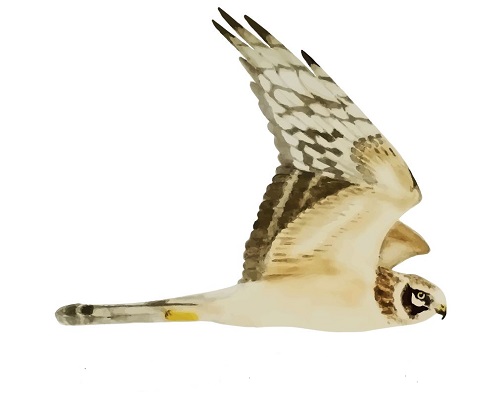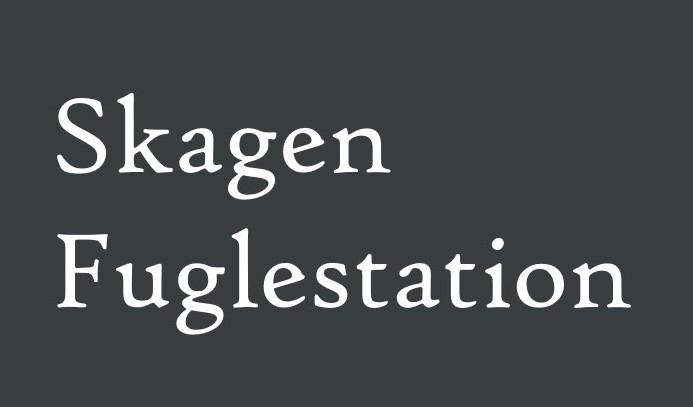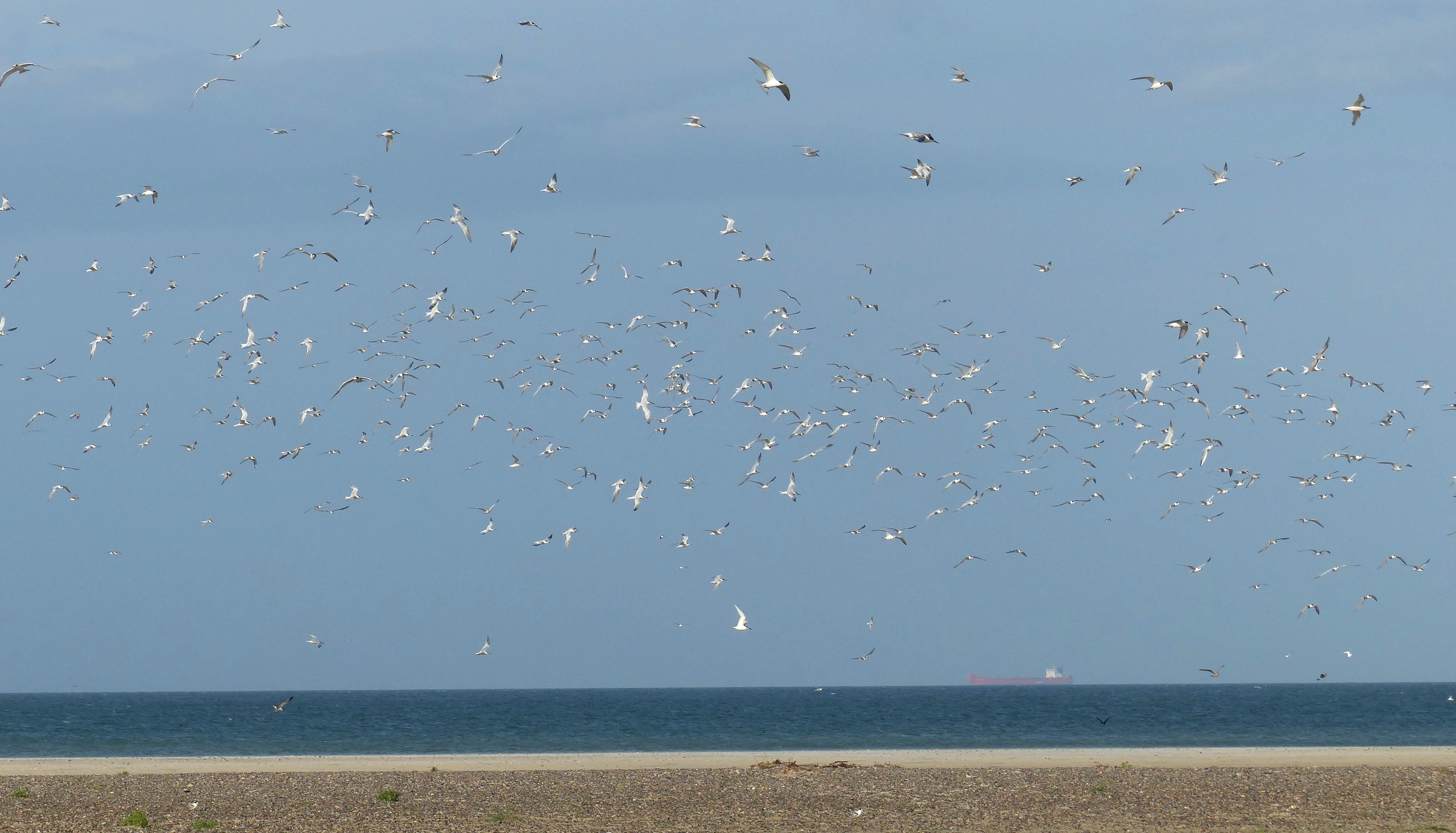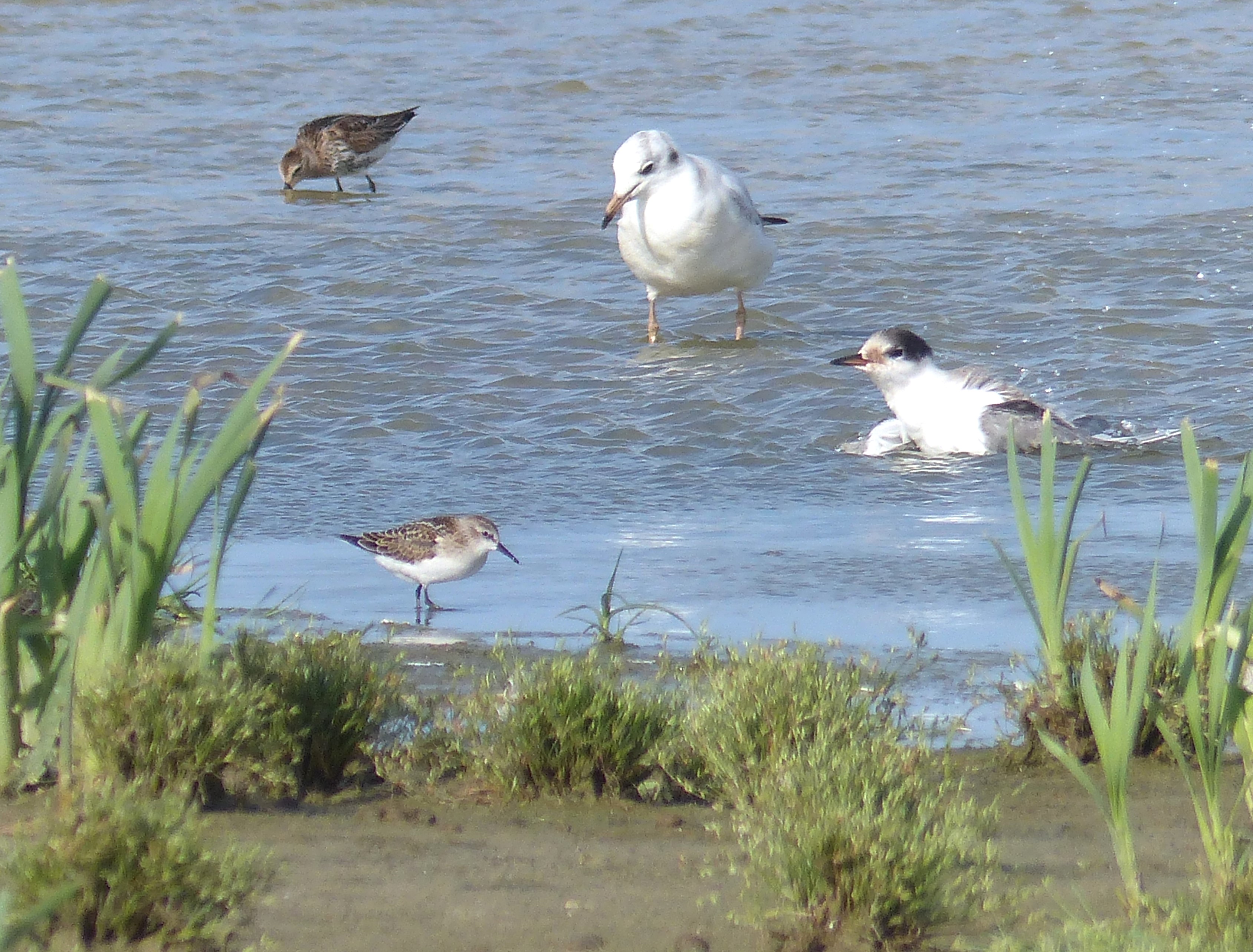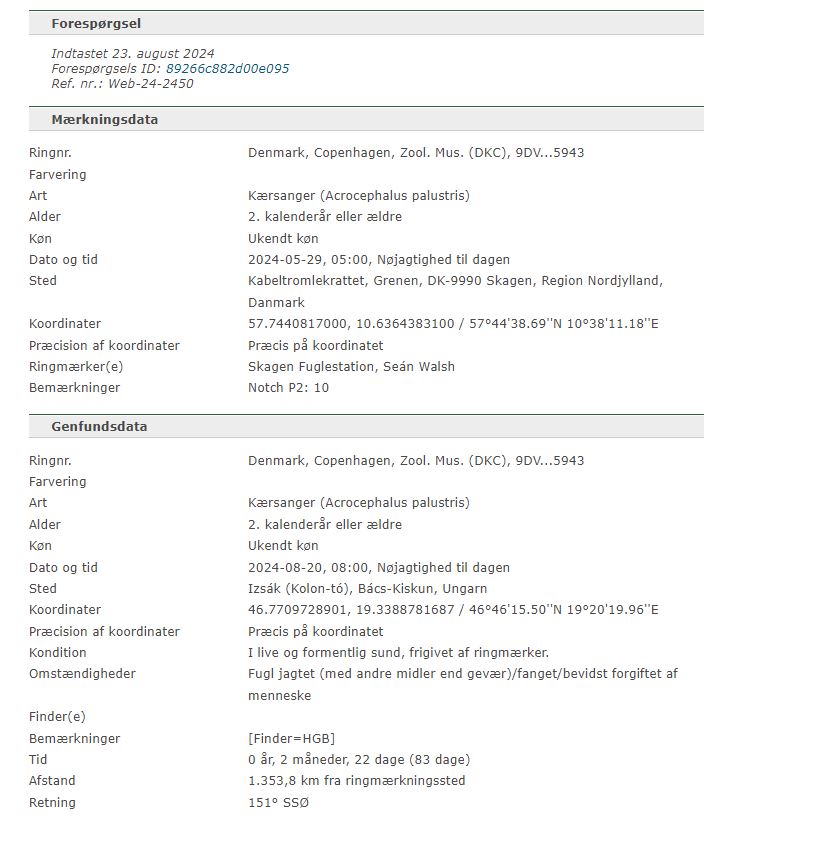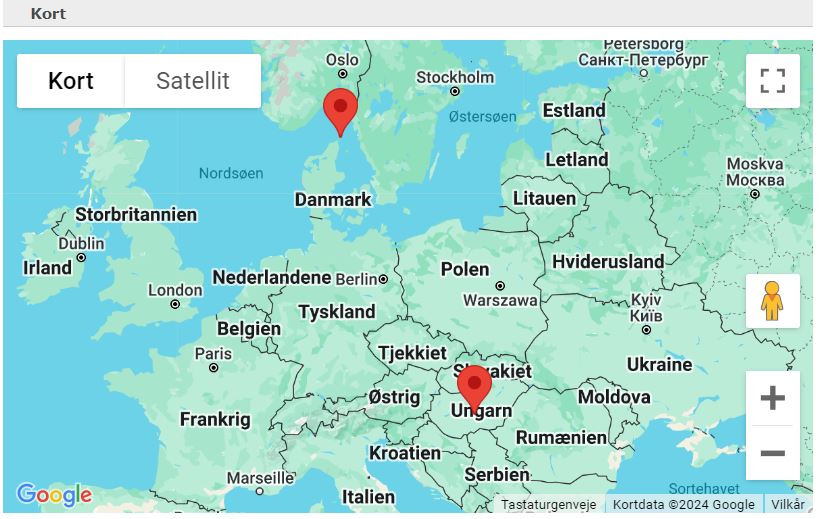Her på Skagen Fuglestations blog bringes korte nyheder i dagbogsformat om hændelser på fuglestationen.
Se indlæg fra måned: feb. (16)mar. (30)apr. (30)maj (31)juni (30)juli (31)aug. (31)sept. (30)okt. (31)nov. (29)dec. (11)
First day of autumn brings about a record and new people!
1/9 is the first autumn day in started with the usual routine of going to Worlds End 3. The day didn’t bring about another rarities BUT we completely blew apart the old Skagen-record for Mediterranean Gulls, with 12 individuals counted at the same time! All of them 1k birds, no nice adults, but still cool to see so many of this once quite rare bird in Denmark! Of other nice birds was a Common Kingfisher that flew by us before sunrise at the OP. My first ever seen in Skagen, same goes for Frederik. Of other rarities was the fact that the entire observatory was out doing the obs, so everyone got a share in fun that is counting migration as we had no one with a C-license at the Kabeltromlen today. With nice observations of arctic skuas and other seabirds it was still nice, though there was no migration. Everyone went back when the obs stopped, but me and Frederik stayed longer since a trawler was heading towards harbour with a bunch of fulmars following, so we tried to see if we could find another Balearic Shearwater or something better, but no dice, except 18 fulmars
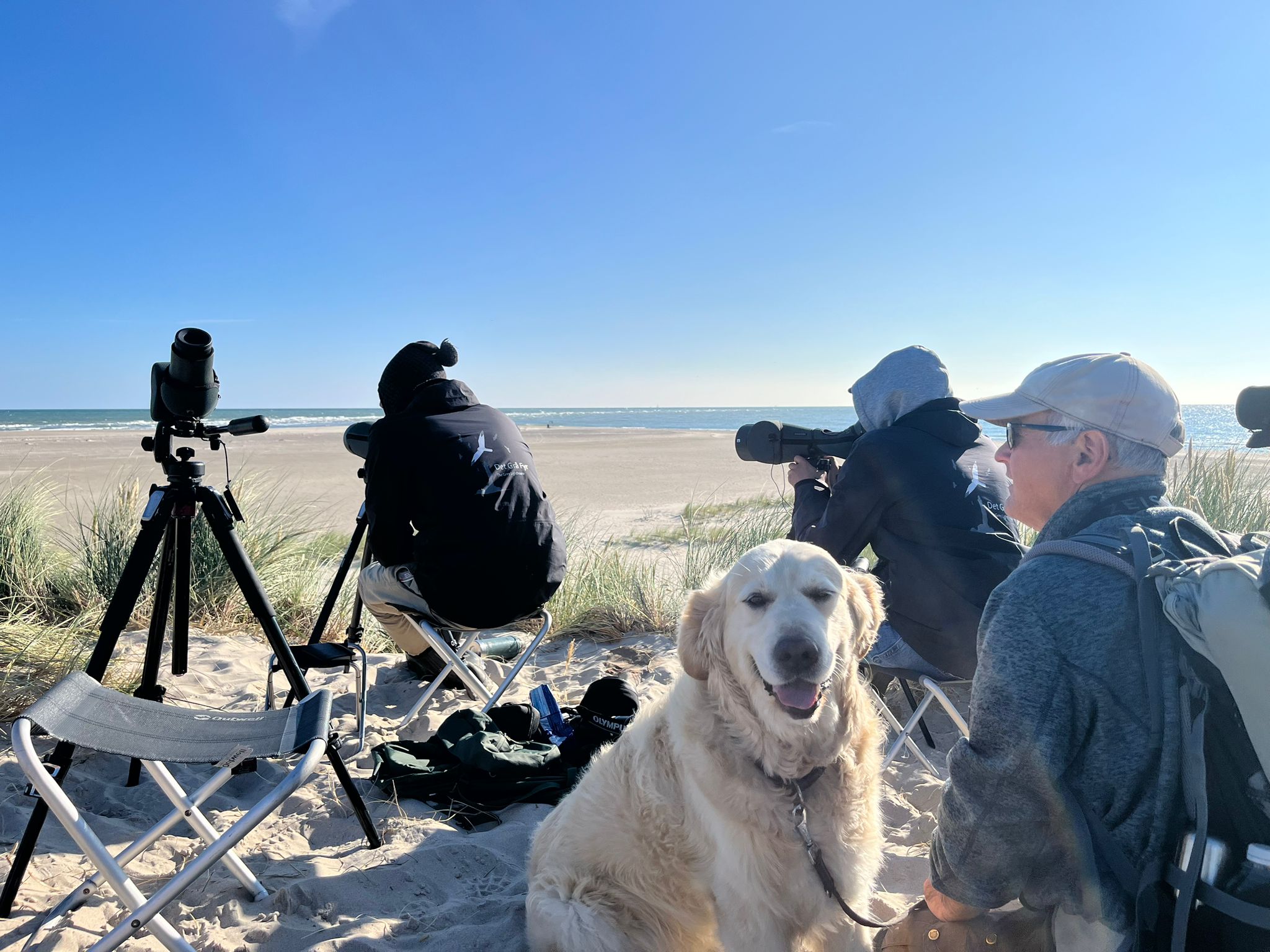
SKAF's emotional support pet - Igor, has probably seen more bird species than most birdwatchers
Ezra had to leave though as he had to return to the UK, we wish him safe travels and good luck with all future endeavours, it was nice having you here! After the obs me and Frederik went through Ellekrattet where we found a quite late brood of Icterine Warblers with younglings getting fed. We hope they have a safe travel to Africa, if not, we hope that they will make some rarity finder very happy somewhere.
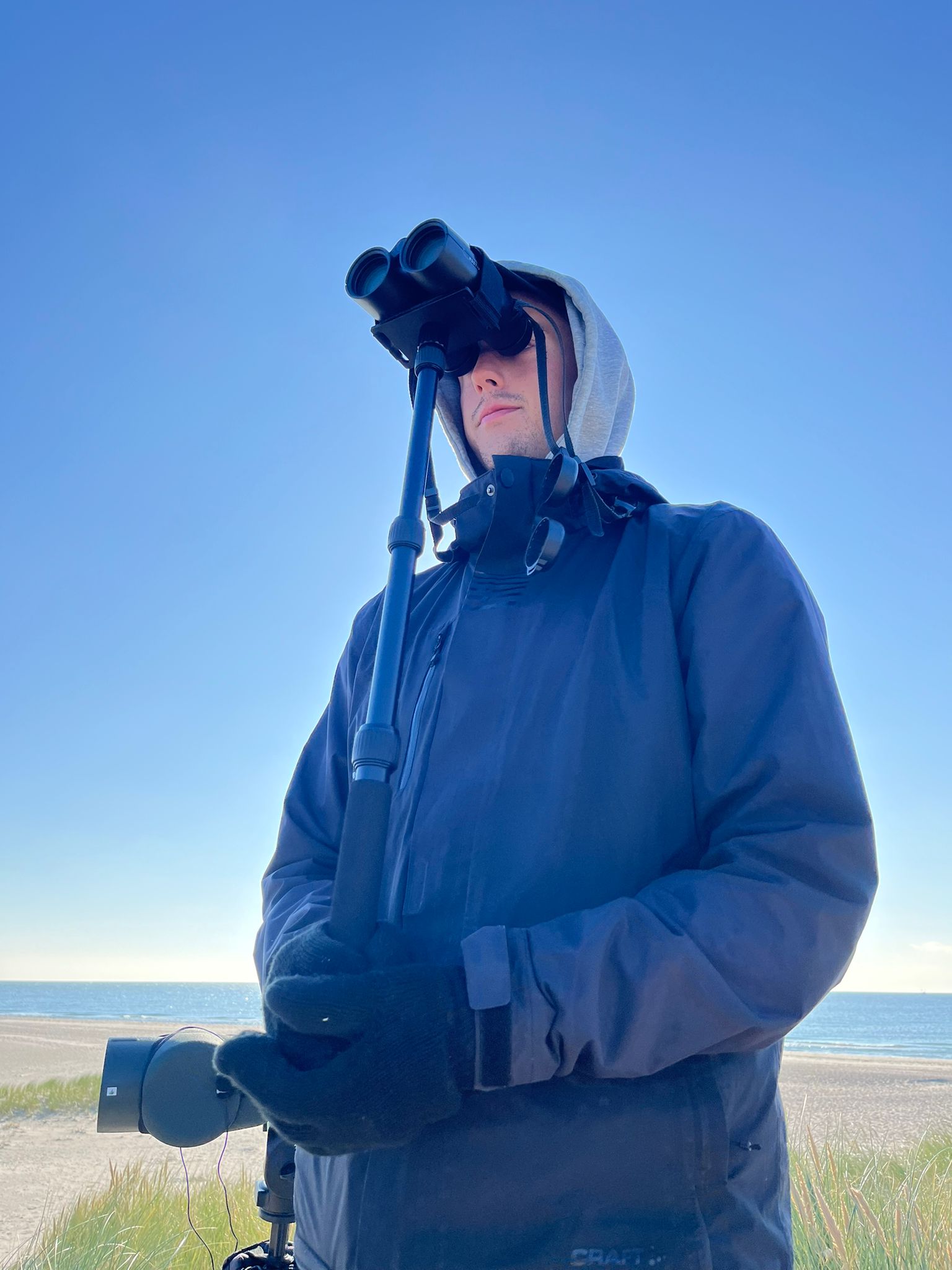 The finnstick - here implemented expertly by Frederik Johansen
The finnstick - here implemented expertly by Frederik Johansen
At the station we all took long naps and Hans had to leave, it was a great joy to have him also, had we hope returns soon and bring some more rare birds with him to Skagen. We then got ready for storm petrel catching and greeted the new guests that were going to stay at the Apartment, Ole and Birgitte, who are going stay with us for the week and along with them Mara our new volunteer from Germany also joined us! Two people left, three more arrived, There is always people at the station, an international revolving door.
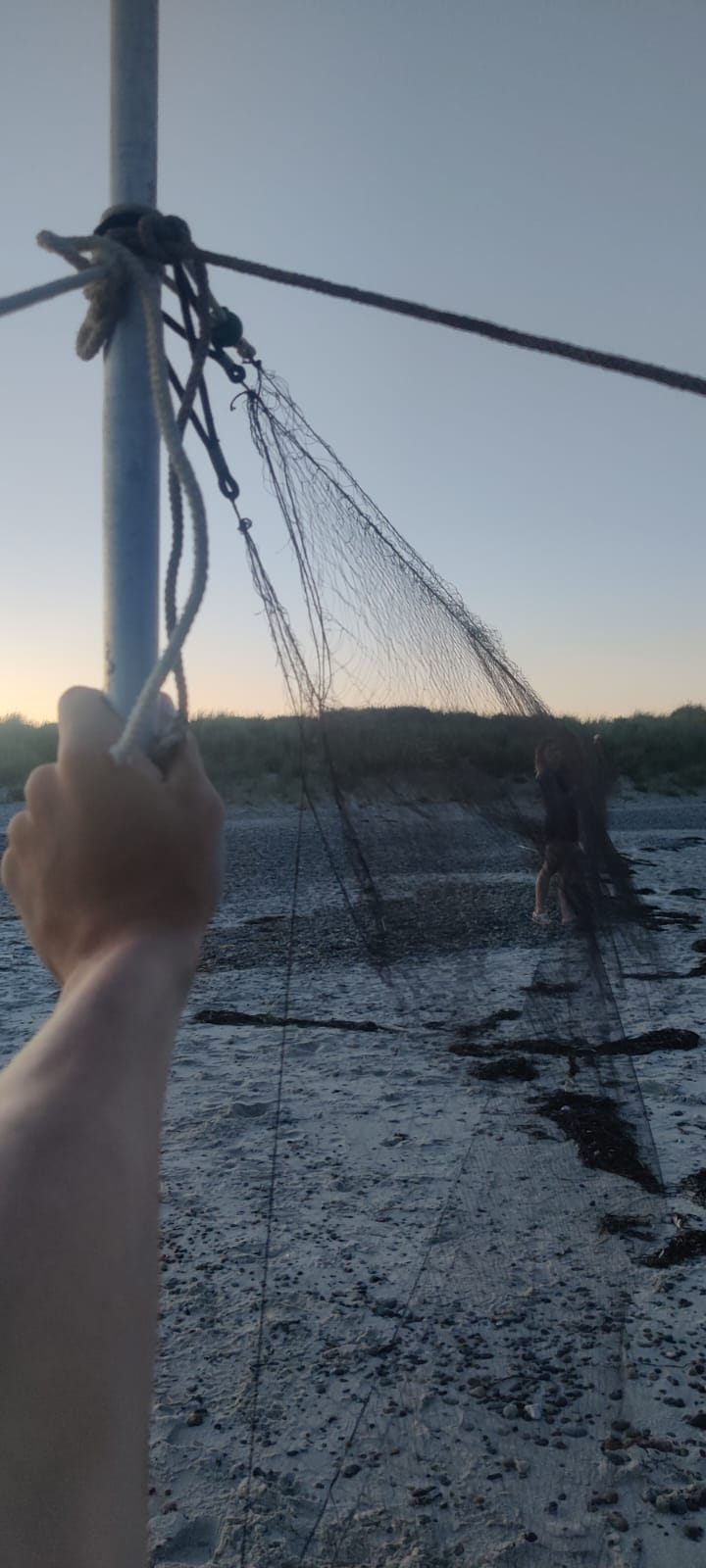 Prepping the nets for storm petrel catching
Prepping the nets for storm petrel catching
Now we wait for a Storm Petrel to be caught, otherwise fingers cross for a good morning obs!
Ringing (Kabeltromlen):
Total: 0
Link to today's observations from observers in the area
People at the station: Ragnar Smith, Rosa Hicks, Fredrik Johansen, Ezra Sherwell, Simon Sigaard Christiansen, Hans Christophersen, Augustin Sticksel, Ole Jørgensen, Birgitte Jørgensen, Mara Glan
The good birds keep on coming
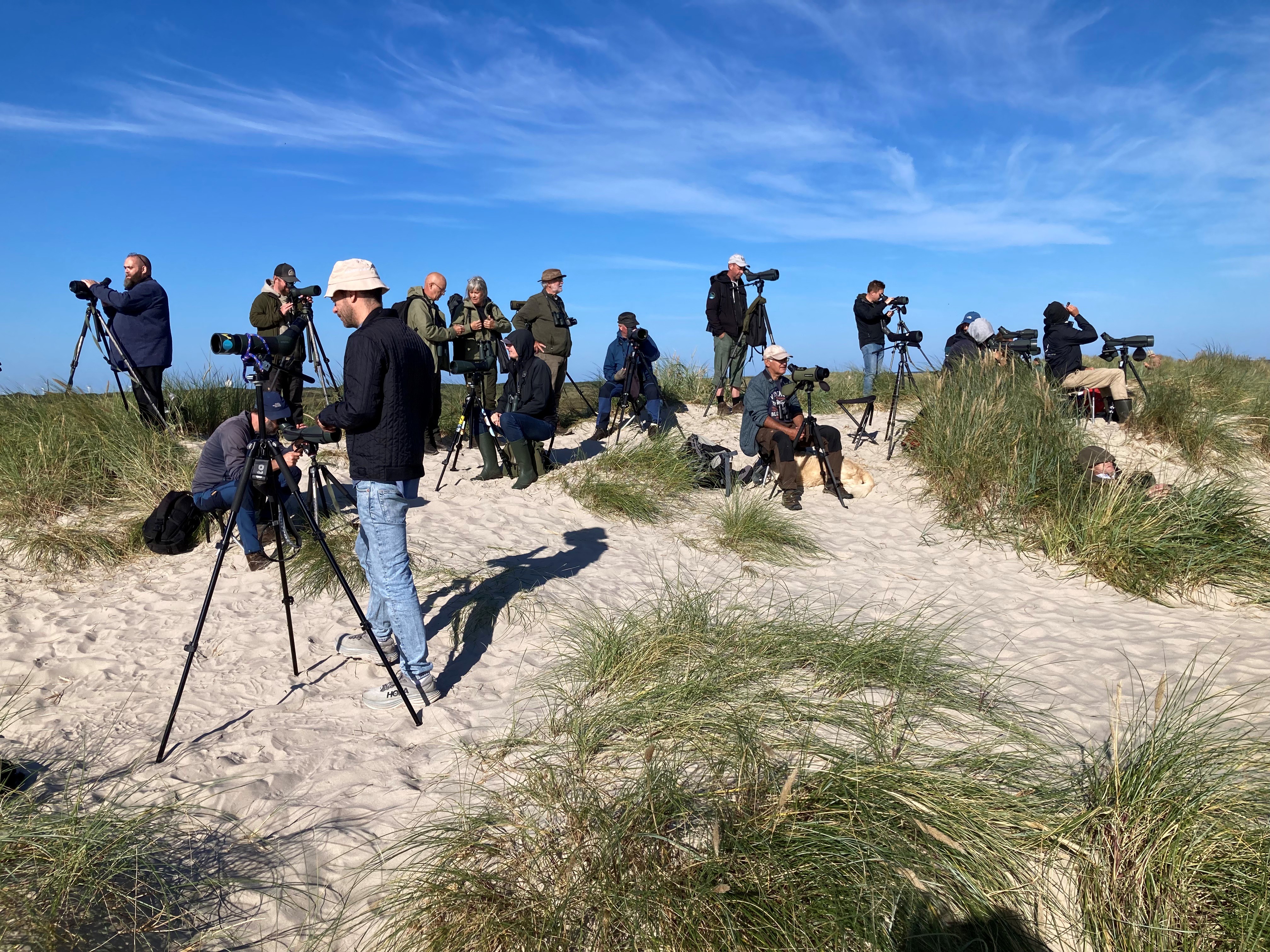 A lot of birders today came out to Verdens Ende 3.
A lot of birders today came out to Verdens Ende 3.
Ragnar, Frederik and me went out observing this morning and were joined by a lot of Danish birders that came with the high hopes of seeing the Bown Booby (Brun Sule) which unfortunately didn’t show up today. But we still had a great time out on the dune and got a great view on a Long tailed Skua (Lille Kjove), one Red-necked Phalarope (Odinshane) and several Mediterranean Gulls (Sorthovedet Måge)! But the biggest highlight by far was Igor:)
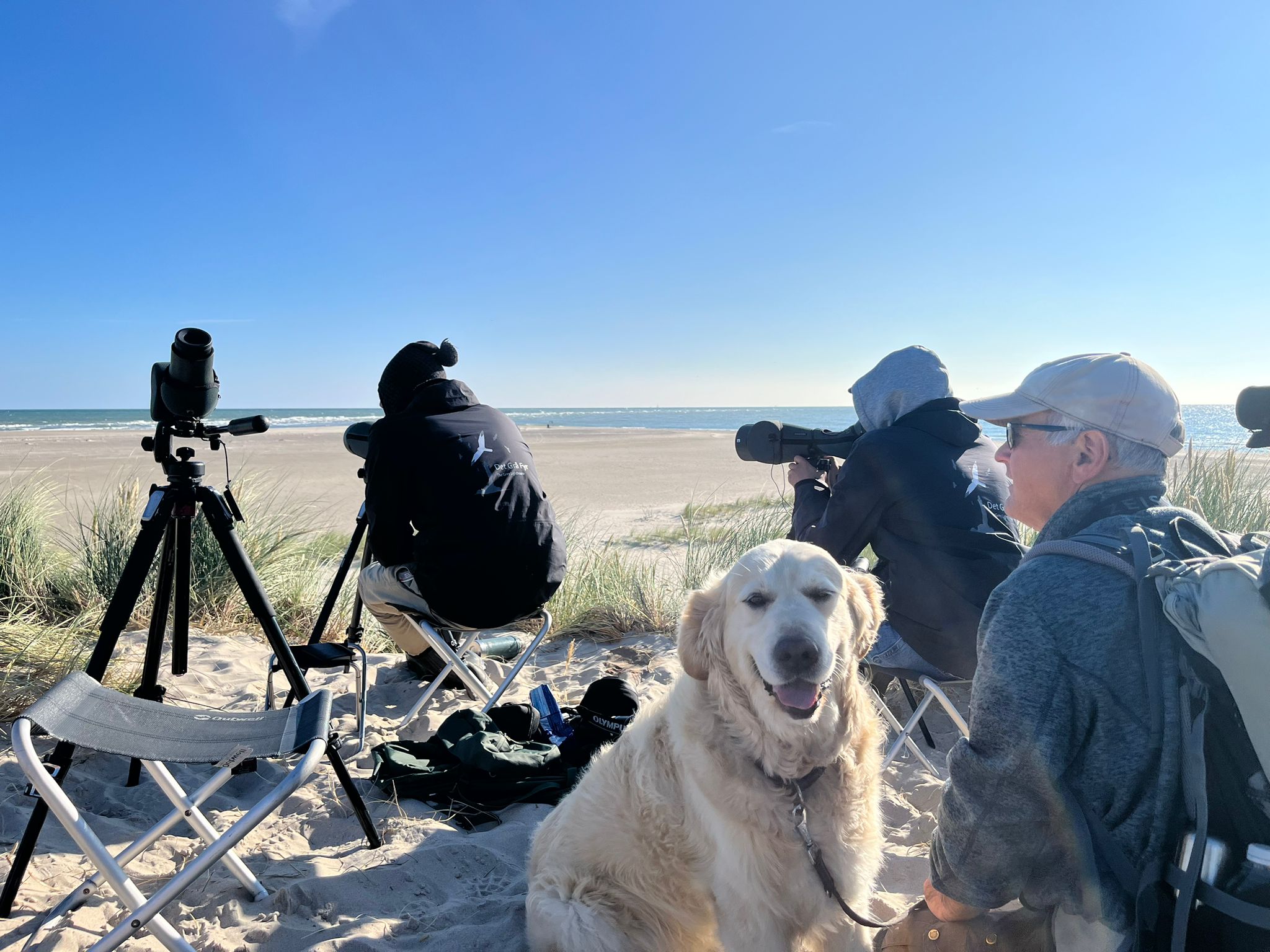
The most handsome dog in Skagen!
Ezra and Rose were ringing with Oluf, they unfortunately didn’t catch big numbers of birds but the ones they caught were very cool! They managed to ring one Kingfisher (Isfugl), Nortern Wheatear (Stenpikker), Common Redstart (Rødstjert), beautiful birds!

Ezra ringing the Kingfisher.
In the afternoon we entered our data, gave the apartment a good cleaning and relaxed a bit. Right before dinner Ragnar and Frederick spotted a fishing boat coming in from the sea and found two Fulmars (Mallemuk) that were following it. We had dinner with Mikkel because hes sleeping at the station tonight.
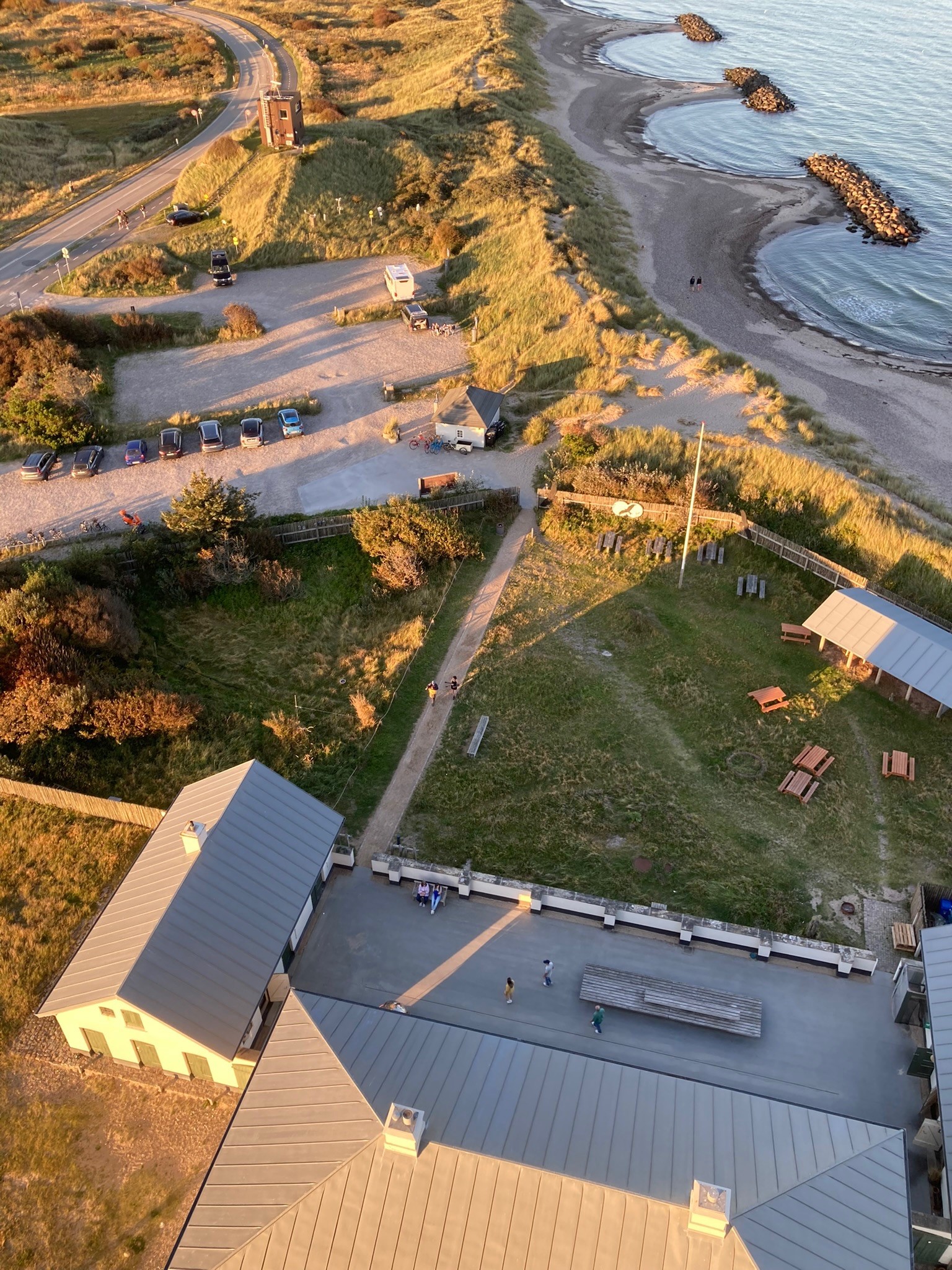
Hans Christophersen took a picture of Rose and me carrying the scopes back to the station before dinner.
Link to todays observations from observers in the area
People at the station: Ragnar Smith, Rosa Hicks, Fredrik Johansen, Ezra Sherwell, Oluf Lou, Hans Christophersen, Augustin Sticksel, Mikkel Høegh Post.
On the move - Wheatear, Whinchat and Redstart
Hi everyone,
With sunrise getting later Rosa and I had the luxury of an extra 15 minutes sleep in this morning as we only had to be out by 5am for ringing. We were kindly joined by Oluf to head up our ringing efforts which, while slow and steady, produced a nice selection of species, the highlights being redstart (Rødstjert), whinchat (Bynkefugl) and wheatear (Stenpikker).
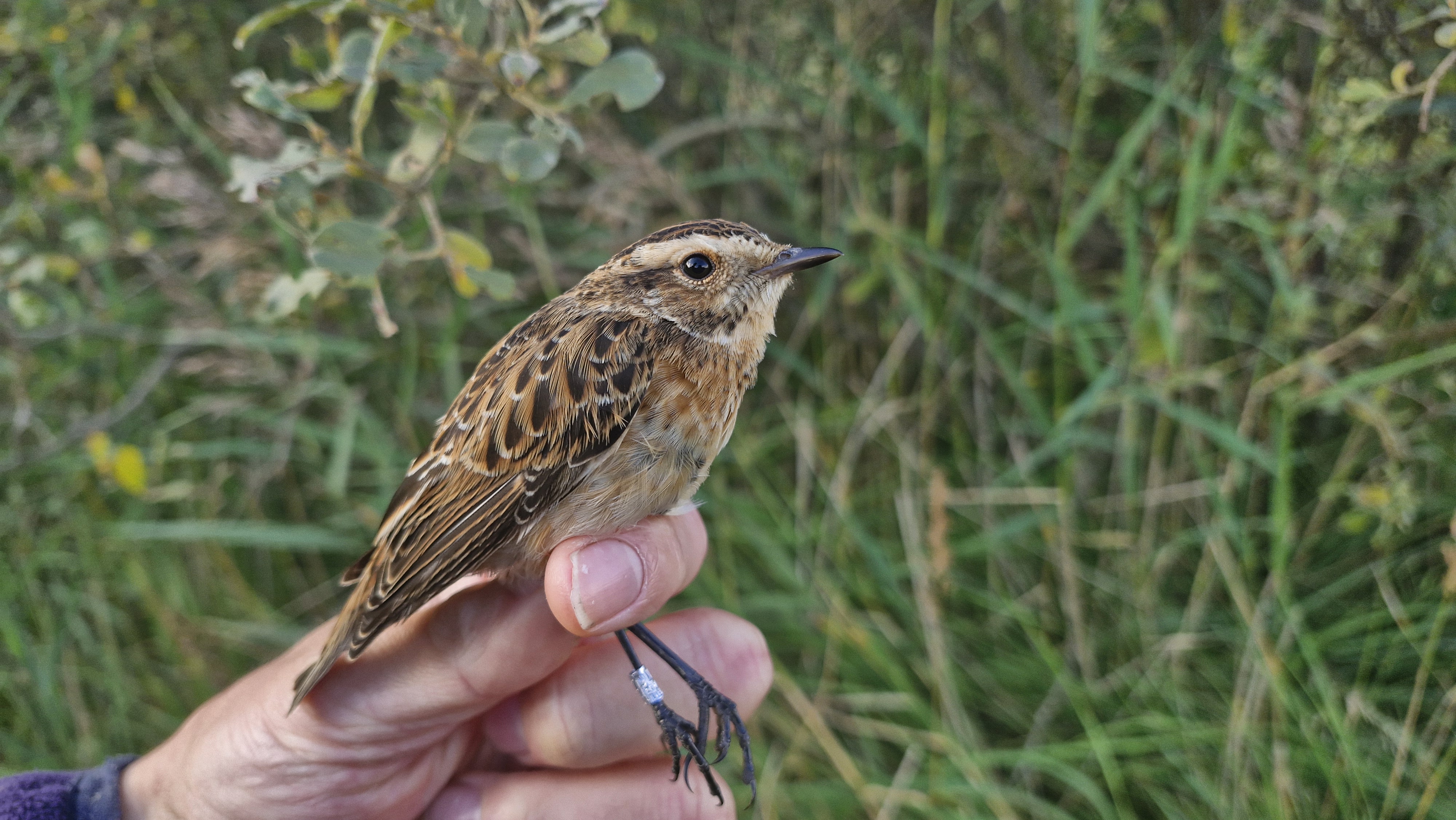
A first year Whinchat (Bynkefugl)
Meanwhile, Augustin, a new volunteer from Germany who arrived in late last night joined Ragnar, Fredrik and Hans out at Worlds end 3 for some seawatching which produced a return visit and some good views of the brown booby (Brun Sule) as well as a total of 15 arctic skua (Almindelig Kjove), 1 great skua (Storkjove), a little tern (Dværgterne), several little gulls (Dværgmåge) and mediterranean gulls (Sorthovedet Måge), and 37 wheatear (Stenpikker) being the highlights.
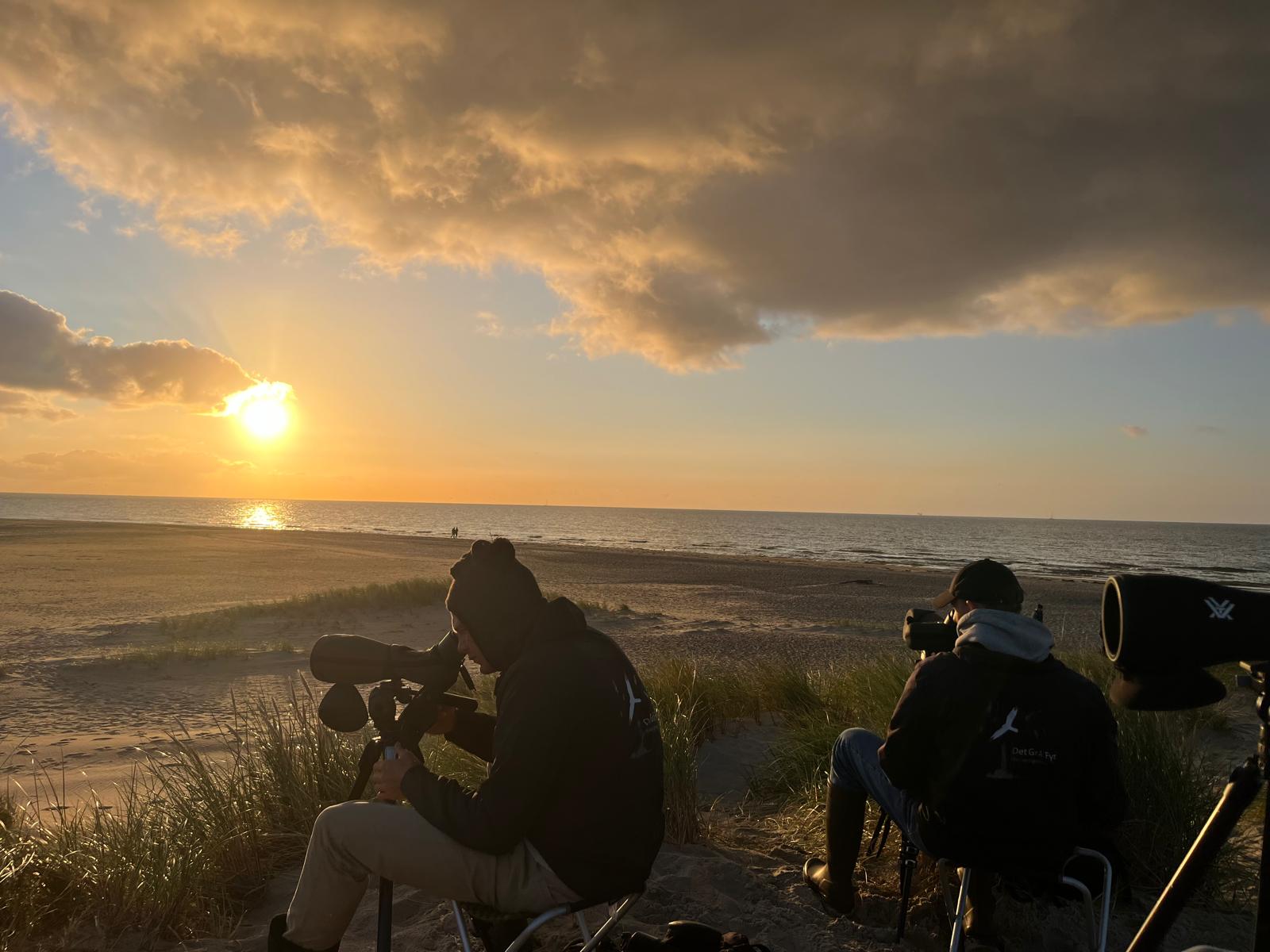
Sunrise with the observers at World end 3.
After lunch, several of us headed west, largely on our own separate walks with a goshawk (Duehøg), several redstart (Rødstjert) and good numbers of whinchat (Bynkefugl) and wheatear (Stenpikker) the highlights. On my way back I called into a small patch of largely coniferous woodland towards the southwest which produced crested tit (Topmejse), tree pipit (Skovpiber), spotted flycatcher (Grå Fluesnapper) and a juvenile great-spotted woodpecker (Stor Flagspætte) to add to the days totals.
Ringing (Kabeltromlen)
Gransanger: 1
Stenpikker: 2
Tornsanger: 3
Munk: 5
Rødhals: 1
Rødstjert: 1
Rørsanger: 3
Bynkefugl: 1
Løvsanger: 4
Totals: 21
Link to todays observations from observers in the area
People at the station: Ragnar Smith, Rosa Hicks, Fredrik Johansen, Ezra Sherwell, Oluf Lou, Hans Christophersen, Augustin Sticksel.
B is for BROWN BOOBY (again)
Hi folks!
Since Ragnar last updated you, yesterday evening, Ezra and I went out to Grenen for some night catching. During the day the flooded pools were full of terns and wader species, so we were feeling optimistic, however we arrived at 22:00 to a nearly empty beach! After trying our luck with a few flighty dunlin (Almindelig Ryle) and sanderling (sandløber) we came across a common tern (Fjordterne), which we were able to catch and bring back to the station to ring and take biometrics of – a new species to catch and see up close for both Ezra and me.
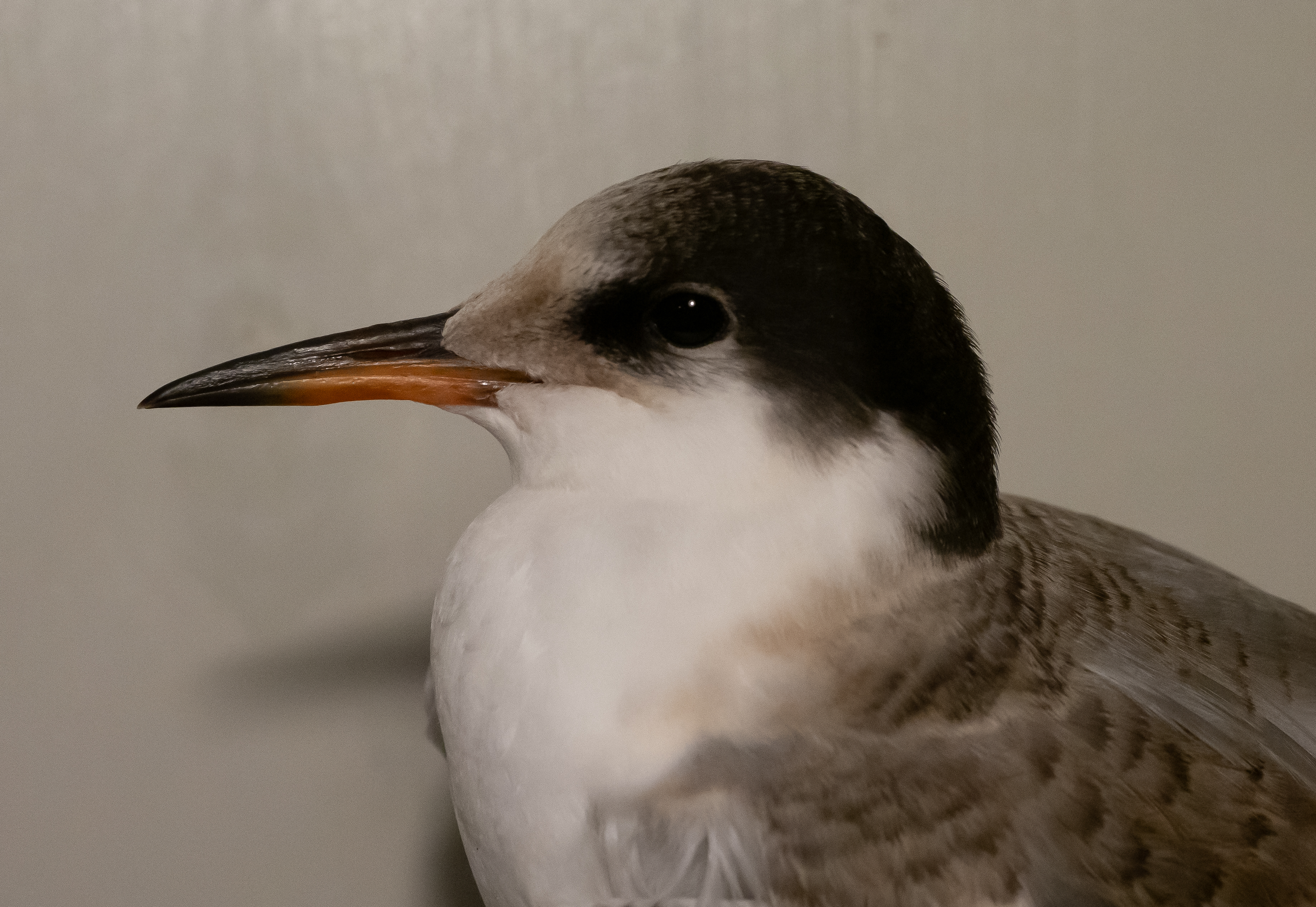
A first year common tern (Fjordterne).
After a slightly later night and shorter nights sleep, we were up once again for ringing and observations. The ringing was a little slower than the past few days, with 15 new birds captured, and highlights being a sedge warbler (Sivsanger) and two spotted flycatchers (Grå Fluesnapper). A nice addition to the session was an excellent view of a red footed falcon (Aftenfalk), which Ragnar and Simon spotted coming off the sea, before flying right over our heads, giving us incredible views to see identification features like the dark “cap.”
Towards the end of the session, I got a very exciting phone call – the brown booby (Brun Sule) was back!!! Having missed it the other day I was very excited to say the least, and after failing to identify it confidently from the juvenile gannets from Kabeltromlen, I ended up cycling and running to Worlds End 3 to great the boys and the booby (yay!!!). Ragnar and Fredrik then stayed for an extra 3 hours to help birders view the bird, while we closed the nets at Kabeltromlen.
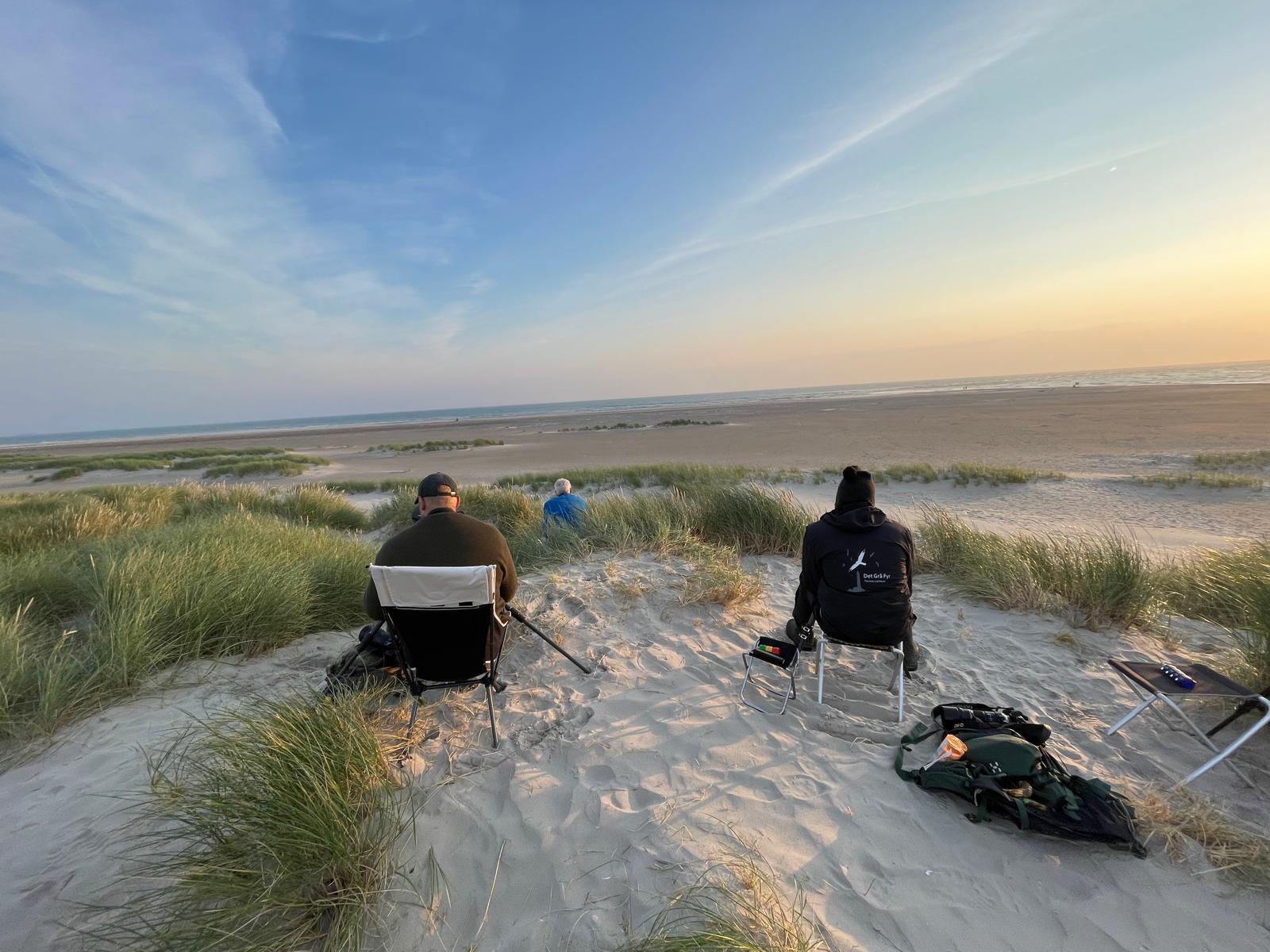
The observing team doing what they do best.
After a bite to eat, Ezra and I headed out on separate birding escapades to Sandmilen, both seeing decent numbers of tree pipits (Skovpiber), crossbills (Lille Korsnæb), stonechats (Vestlig Sortstrubet Bynkefugl), whinchats (Bynkefugl), yellowhammer (Gulspurv), and kestrels (Tårnfalk). Meanwhile, Ragnar and Fredrik cracked on with some admin, before heading back out to Grenen, for a bit of additional sea watching. This time they spotted a bat species and a wryneck (Vendehals), which is an uncommon autumn visitor to Skagen.
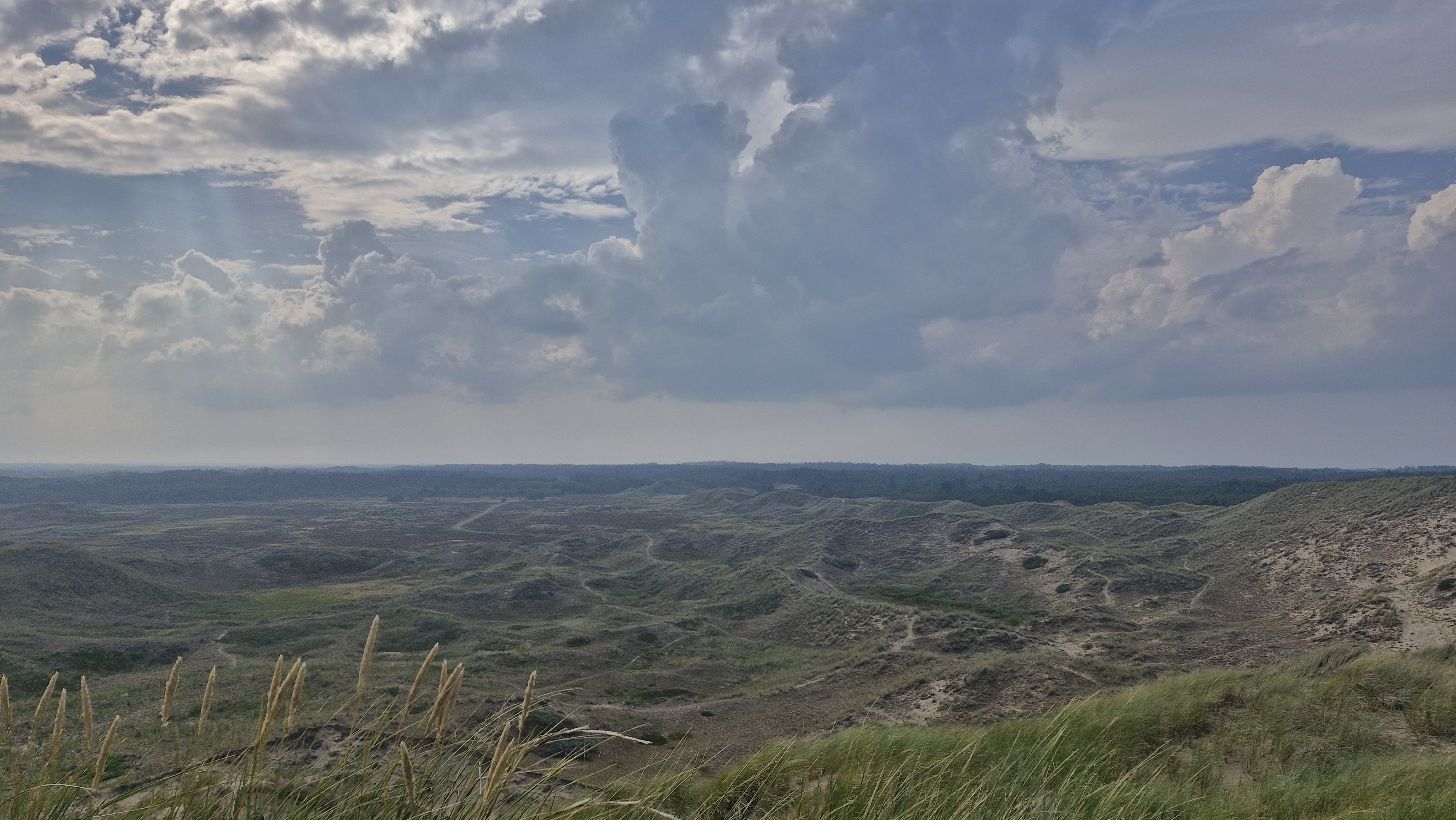
One of the many beautiful views from the higher sand dunes South of Skagen.
We’ve had a brilliant few days, as the autumn season gets underway, so lets see what surprises tomorrow brings with it!
Ringing (Fyrhaven)
Fjordterne: 1
Ringing (Kabeltromlen)
Løvsanger: 2
Gærdesanger: 2
Rørsanger: 4
Munk: 2
Tornsanger: 2
Sivsanger: 1
Grå Fluesnapper: 2
Total: 16
Link to todays observations from observers in the area
People at the station: Ragnar Smith, Rosa Hicks, Fredrik Johansen, Ezra Sherwell, Simon Sigard Christiansen, Hans Christophersen, Birthe Christophersen.
Late august seabird bonanza!
We thought it was over but then it wasn’t.
Today started with me being rudely awakened by Frederik at 0545, reminded me that we were getting late for migration count, but we still managed to be there at 0618, just in time. It was a quiet morning, but in the far distance we see a fishing trawler heading towards Skagen harbour, surrounded by fulmars (Mallemuk) and gulls maybe something else could be following it? I said “let’s see who finds the rare shearwater first” he answers “let the best man win”. Well, he won, at 0906 while counting fulmars, he called out “Sooty Shearwater (Sodfarvet Skråpe)” and I get on the bird, it looks like Balearic Shearwater (Balearskråpe)! Apparently he also had said it for himself (We heard it on his Dictaphone), so we put it on Zello as a possible, and then it landed. When it flew up, we got good views again and got it filmed as it disappeared towards VNV. Another rarity! Two rare seabirds in three days is almost unheard of, especially considering it follows in the heels of the Brown Booby from 26/8. This bird, if accepted by SU (the rarity committee in Denmark) would be 98th record for Denmark and 38th record for Skagen, and the first in seven years for Skagen. What a day.
But now I got that out, the ringers went to Kabeltromlen and there plenty of birds in the bushes and they caught 25 birds, an adult Pied Flycatcher (Broget Fluesnapper) was exciting.
After the migration count we went back to the station to look at videos and I got ready for potentially my first guided tour this season! As a large cruise ship came into the harbour, we were advertising for a Bird Walk tour around in the nearby area, but sadly nobody wanted, even though the sign should have pulled in at least one aspiring birdwatcher, but c’est la vie.
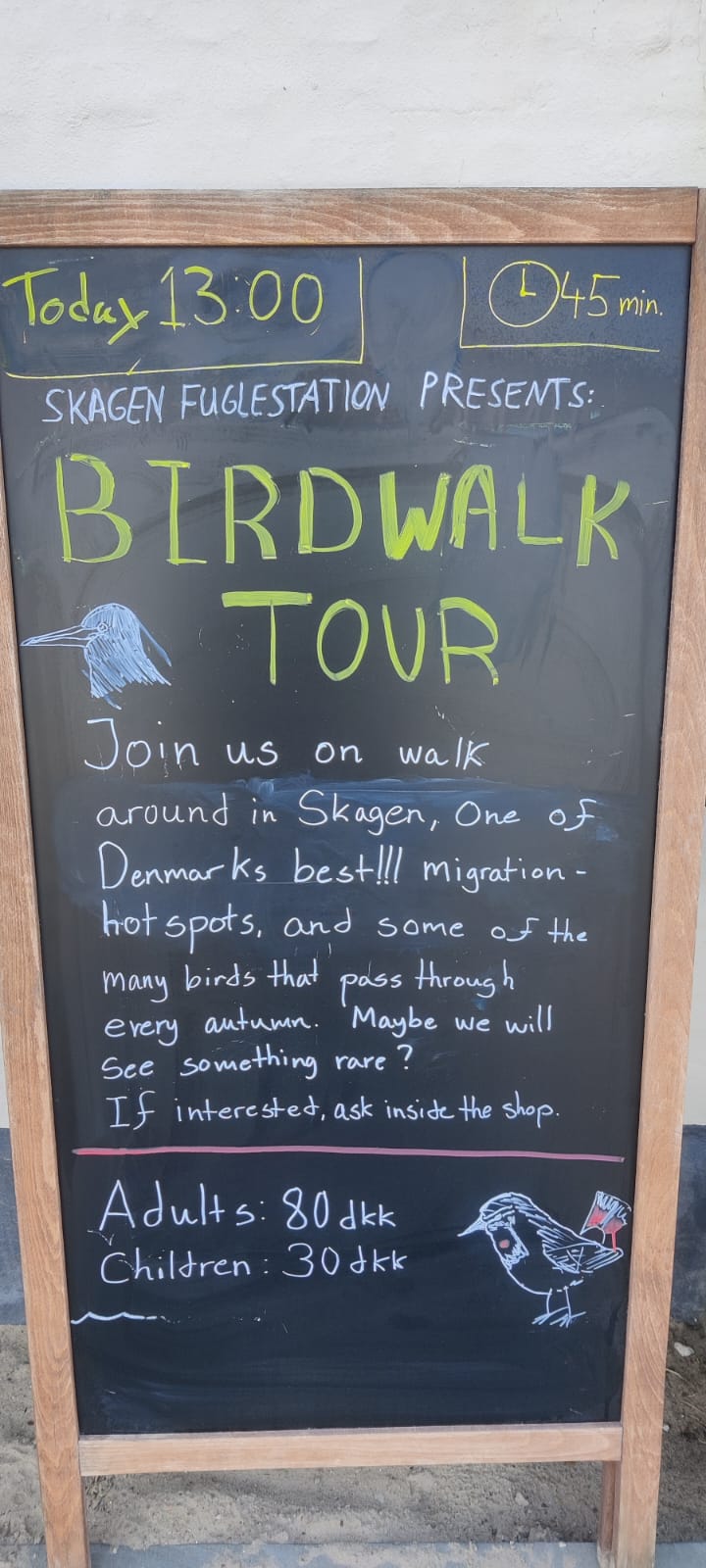 Would join a bird walk, when reading the sign?
Would join a bird walk, when reading the sign?
The rest of day was admin work, chores with Rosa having trouble with the hose and some light birding at Højen Fyr to see if a hattrick could be achieved, but not today. Hans had also been out and about, counted all the sanderlings between Grenen and Nordstrand, picking up his wife in Aalborg and managed to find a Black Kite (Sort Glente)! We are waiting for it to arrive up here.
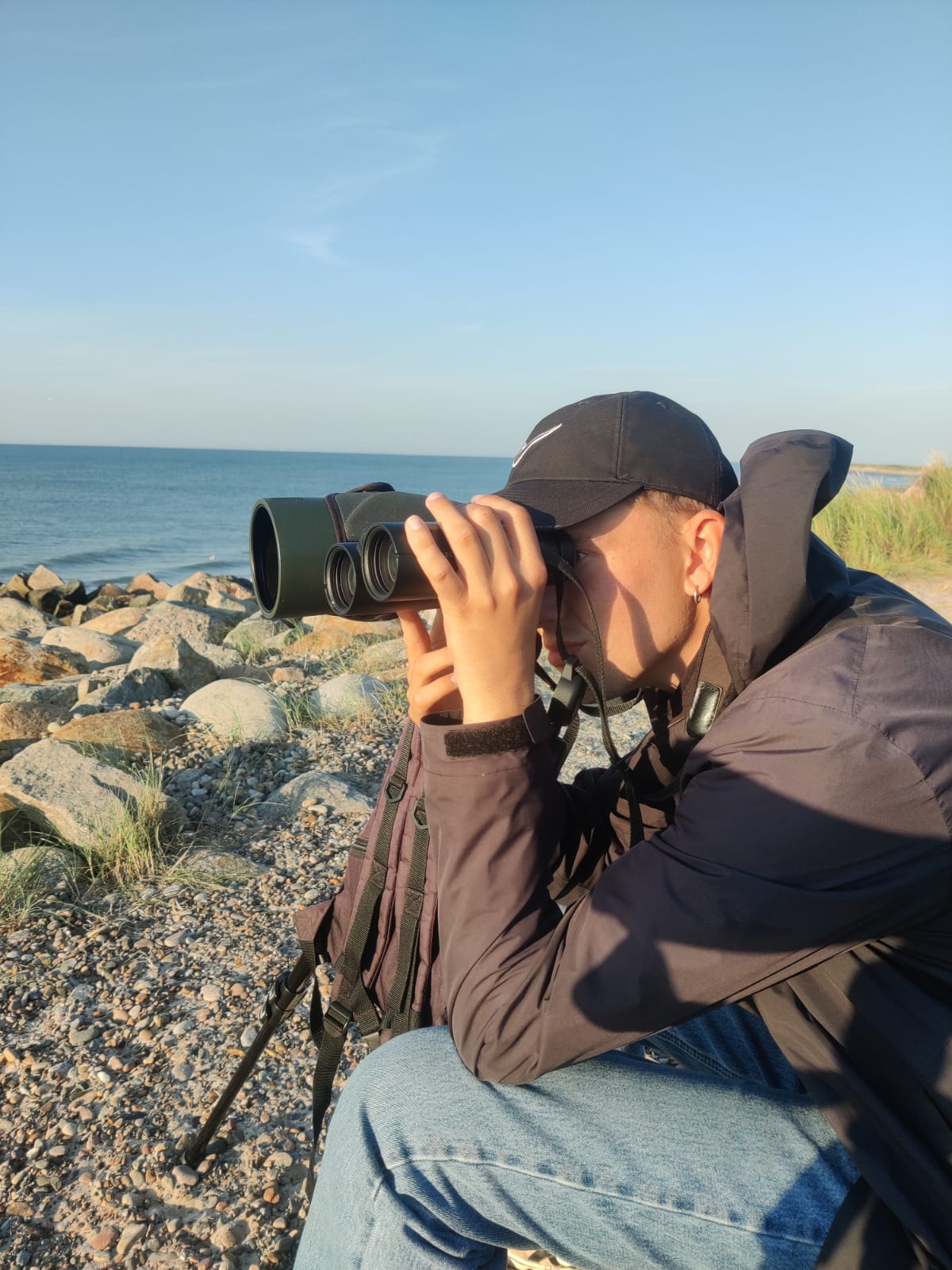 Squeezing the last juice out of the day at Højen Fyr
Squeezing the last juice out of the day at Højen Fyr
We got some ice cream to celebrate for everyone and we got to say hello to Hans’s wife Birthe, who is going to stay here till Friday. Also good to see new faces around here, tomorrow we will be joined by Augustin, who has been here before, new old faces are also always good! Now its late in the afternoon, Rosa and Ezra have gone out night catching, hopefully they succeed, but you’ll find out tomorrow!
Ringing (Kabeltromlen):
Kærsanger (Marsh Warbler) - 1
Rørsanger (Reed Warbler) - 5
Gærdesanger (Lesser Whitethroat) - 4
Tornsanger (Common Whitethroat) - 6
Havesanger (Garden Warbler) - 1
Gransanger (Chiffchaff) - 2
Løvsanger (Willow Warbler) - 6
Broget Fluesnapper (Pied Flycatcher) - 1
Total: 26
Link to today's observations from observers in the area
People at the station: Ragnar Smith, Rosa Hicks, Fredrik Johansen, Ezra Sherwell, Simon Sigard Christiansen, Hans Christophersen, Birthe Christophersen.
Anti climax
After the greatest observing succes yesterday with a magnificent BROWN BOOBY (brun sule) found by our very own Ragnar, then our hopes for today were HUGE!
The morning started with Ragnar and I going to world’s end 3 to observe and Ezra, Rosa and Simon going to Skarvsøen for CES ringing.
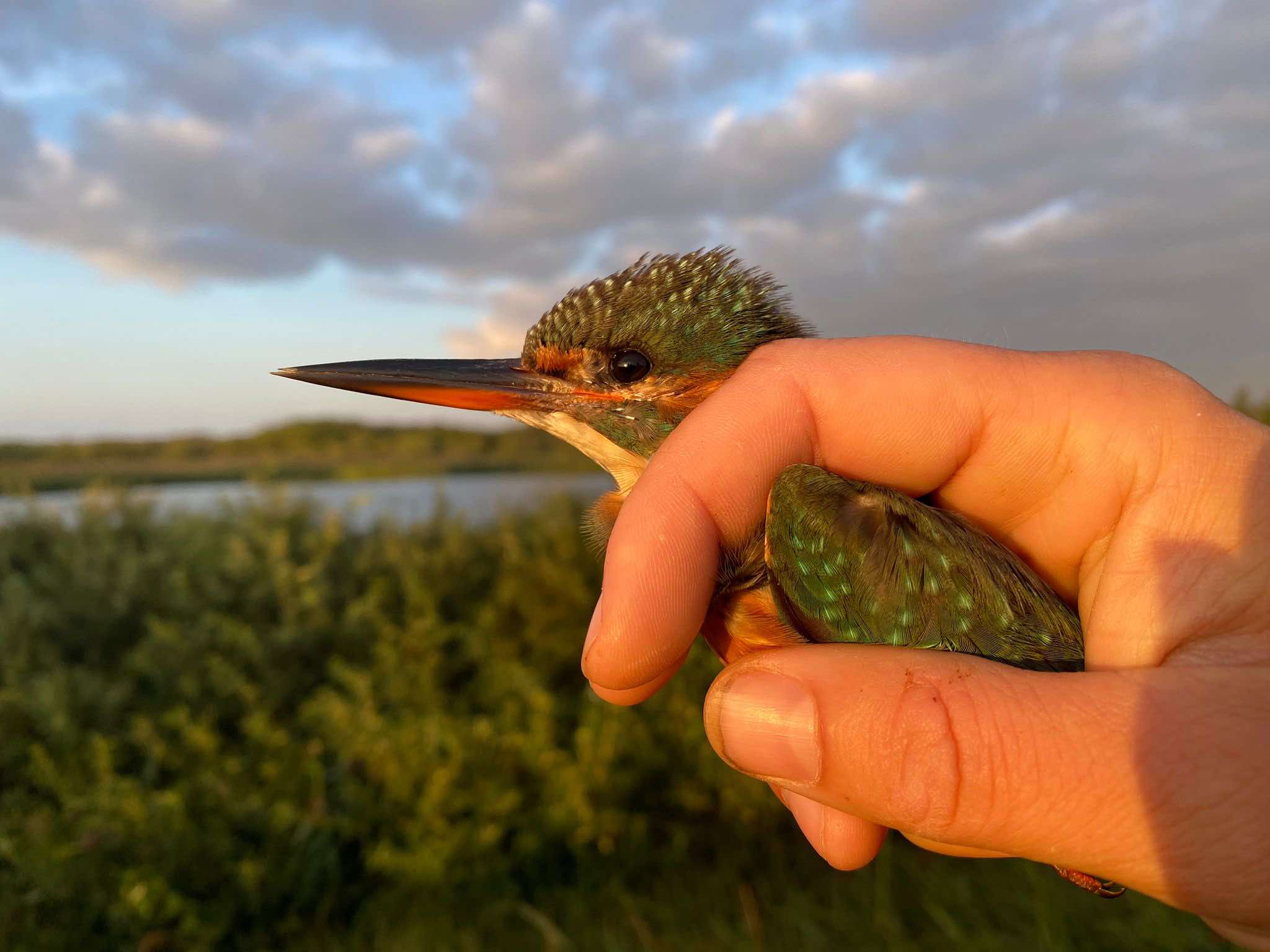
The ringing period gave a good amount of birds. They never had a round with less than 10 birds and they caught a beautiful Kingfisher (Isfugl) as one of the first birds. They also had a flock of 14 common buzzards soaring above the site at 11 around the time they had to take down all of the nets for maintenance.
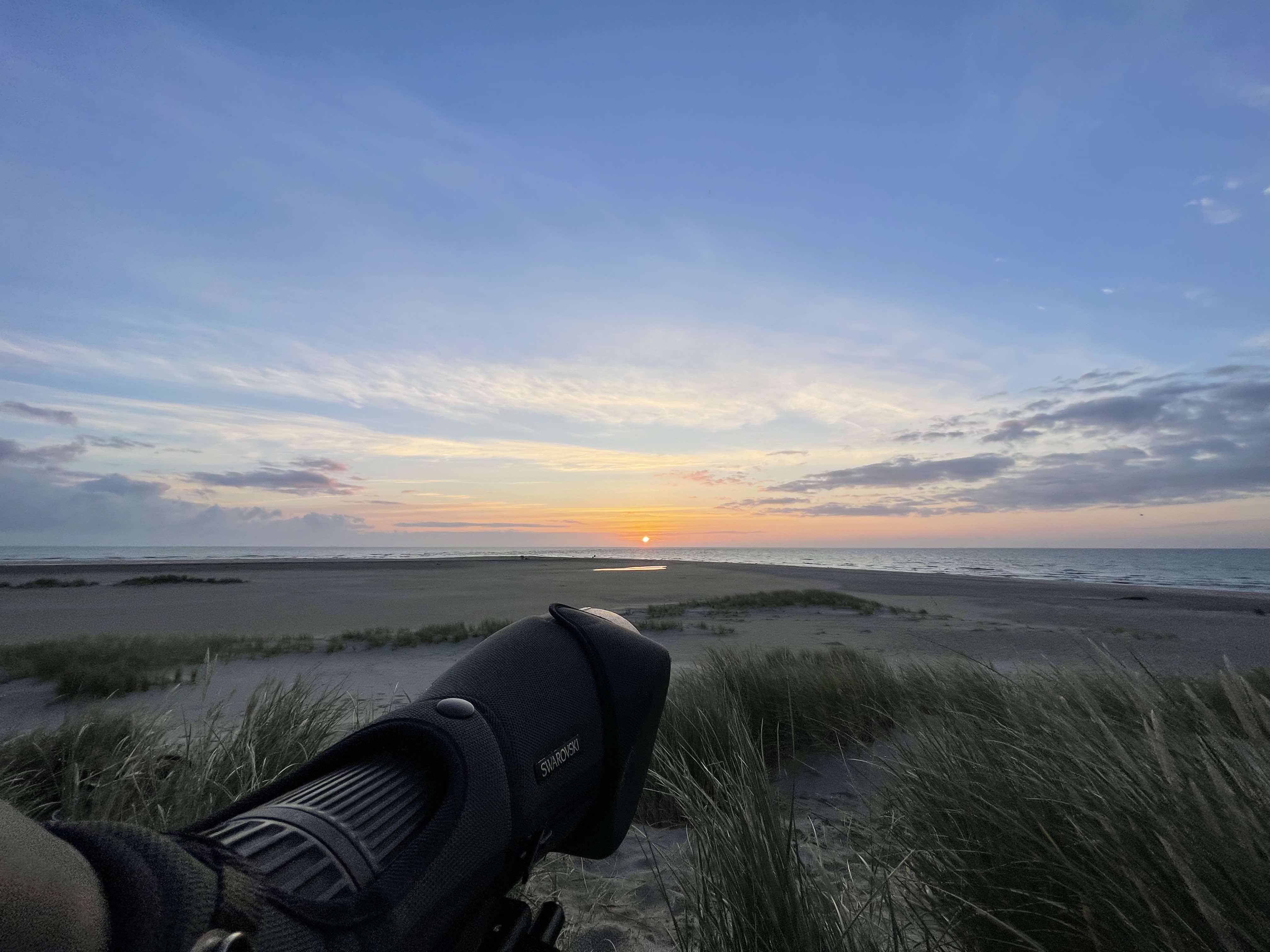
The observing where quite slow today. There was no migration over the sea today compared to yesterday, but the passerine migration disappointed today even though the weather forecast had said it should have been a good day for it. But we managed to get some good species anyways like a calling wood warbler (skovsanger), which was pretty cool! Later Hans joined us for the migration and sometime after Jørgen and Igor came by.
Hans hadn’t seen much but counted many roosting terns on the beach. And a cuckoo and some arctic skuas.
Over the seas as well as on the beach as mentioned before, there were a huge present of common tern with around 832 in total! 700 over the seas at one point in the early morning.
After ended migration count, Ragnar and I went to look after warblers. We started off at Kabeltromlen where we had a good amount of willow warbler (løvsanger), whitethroat (tornsanger) and more of the common species. When Kabeltrommel warbler mission was completed we went to Ellekrattet and had not one, but two wood warblers foraging in the tree crowns and just a fair amount of warbler individuals.
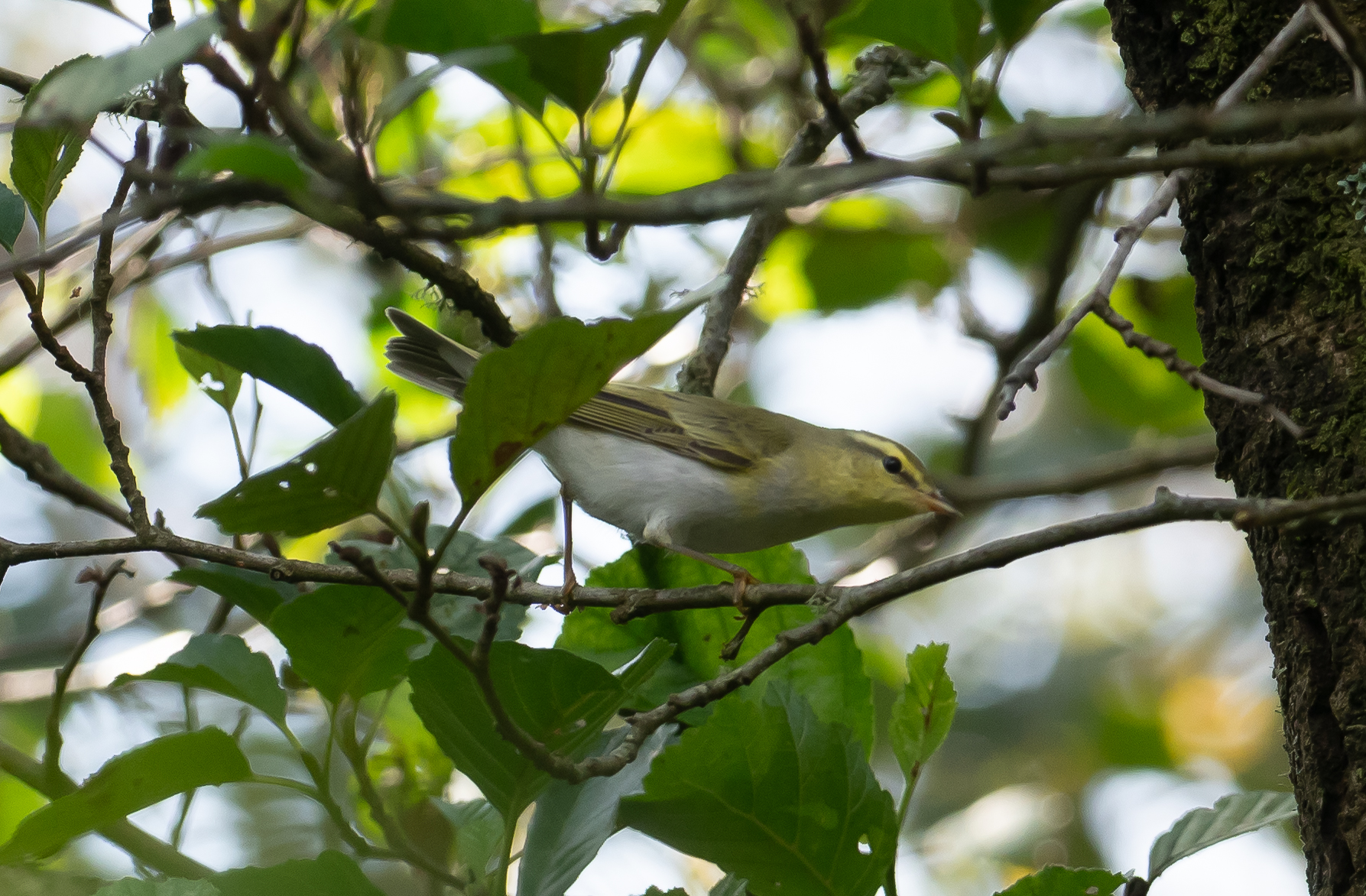
When lunch had been consumed we went out to the area around Buttervej and looked for passerines there. We had a skulky reed warbler, one of the last red-backed shrikes (rødrygget tornskade) this year, a garden warbler (havesanger) and some wheatears (stenpikker) and stonechats (sortstrubet bynkefugl).
Hans had been on a loooong walk (or several walks) around Skagen. First to count the nice terns and waders at Grenen and Nordstrand and then down to stokmilen to look after the beautiful swallowtails (svalehaler) which had been around the area for a long time until some time last week or the week before. No success unfortunately.
Ezra and Rosa have been on their own individual birding mission but didn’t add many new species to the day’s total.
This late afternoon and evening we have been completing chores that needed to be done and now we are ready for the new adventures of tomorrow!
Goodnight.
Today's CES ringing data from Skarvsøen:
Water rail / Vandrikse 1
Kingfisher / Isfugl 1
Blue tit / Blåmejse 5
Willow warbler / Løvsanger 6
Chiff Chaff / Gransanger 3
Reed warbler / Rørsanger 24
Marsh warbler / Kærsanger 1
Garden warbler / Havesanger 1
Lesser Whitethroat / Gærdesanger 1
Whitethroat / Tornsanger 4
Blackbird / Solsort 1
Robin / Rødhals 1
Reed bunting / Rørspurv 3
Total: species (13) and amount (52)
People: Ragnar Smith, Rosa Hicks, Fredrik Johansen, Ezra Sherwell, Simon Sigard Christiansen, Hans Christophersen.
Winds of fortune
Hi everybody
The day started off rather stormy with strong winds leading to a decision not to open the nets. However, Ragner, Frederik, Hans and I decided to brave the weather out at World End 3 for a count. Some of the species highlights from the count included several Arctic Skuas (Almindelig Kjove) and Great Skua (Storkjove), a shearwater (Skåpe), a black tern (Sortterne), a few little gulls (Dværgmåge) and good numbers of gannet (Sule) and kittiwake (Ride) migration along with a few migrating waders. Just before we started packing up we had one final surprise for the survey. A flurry of excitement ensued as a brown booby (Brun Sule) was spotted by Ragnor flying southeast, quite close to shore. As a third record for Denmark, and the first from Skagen, this was very exciting. Having never seen this species before I was also very happy to get to see this bird.
Following the success of the morning I decided to try my luck with the zitting cisticola (Cistussanger), another species I had not encountered before, which, after a short period of searching, I managed to locate.
Meanwhile, Rosa and Hans, on separate trips both found increasing numbers of waders on the pools with species present including curlew sandpiper (Krumnæbbet Ryle), turnstone (Stenvender) and dunlin (Almindelig Ryle).
After a second report of the brown booby we once again ventured out to try and re-find the bird, this time in the pouring rain, to the north beach, although our efforts were not rewarded with any further sightings of this bird.
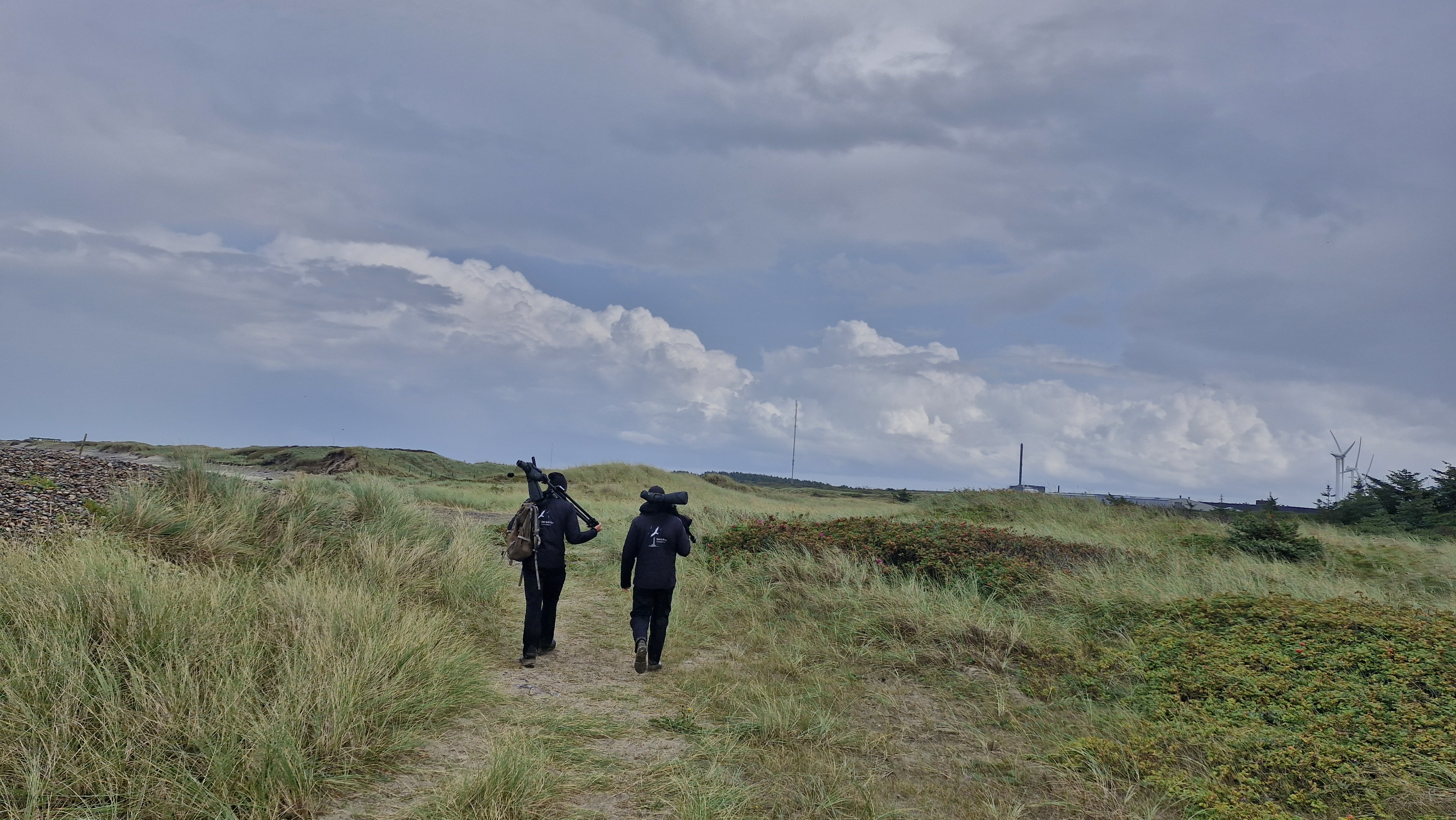
Walking out to Højen Fyrvej to try for a resighting of the brown booby.
Ringing (Kabeltromlen):
Total: 0
We asked you yesterday to tune in for an update on the “meringue Nutella cake with a biscuit bottom”; and we can confirm that it was unanimously described as a success!
Link to todays observations in Dofbasen from the Skagen area
People at the station: Ragnar Smith, Rosa Hicks, Fredrik Johansen, Simon Sigard Christiansen, Ezra Sherwell, Hans Christophersen.
Sunday Fun-day
Hi folks!
Today has been a quieter day after yesterdays’ bird surprises. The day started with Fredrik and me opening the nets at Kabeltromlen, only to get halfway around opening and having to pause our pursuits as a rain shower passed. Luckily the rain quickly stopped, and we could open the remaining nets… only to have to close some more an hour later with the increasing wind speeds! Although we weren’t able to ring many birds today, this was a valuable lesson in reading the weather and online forecast.
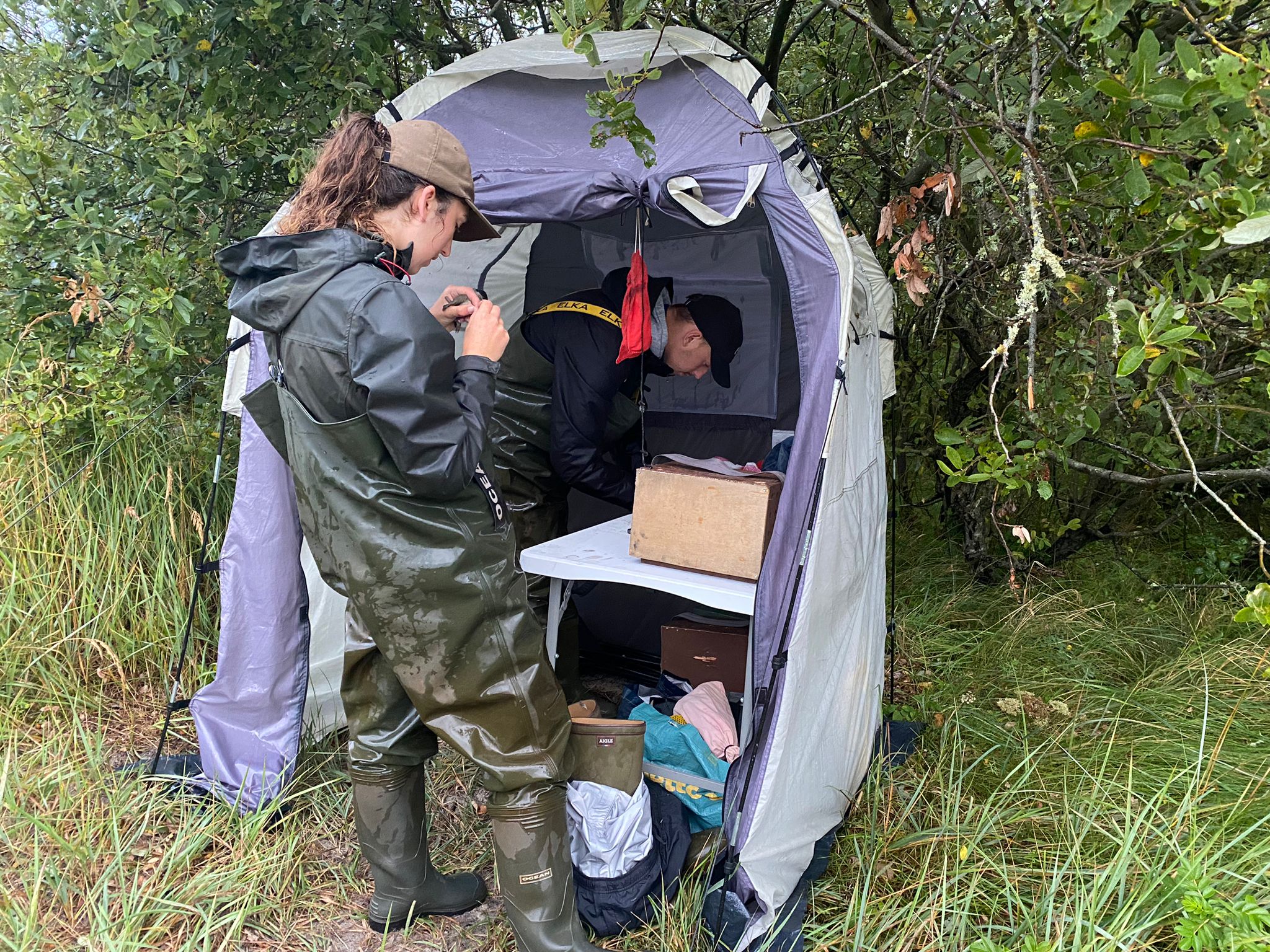
Ringing under the shelter of the tent. Luckily it was a quickly passing shower so we could continue ringing the birds safely.
While we were out at Kabeltromlen, we had some notable observations including a short-eared owl (Mosehornugle), young (1k) goshawk (Duehøg), and hearing the greenish warbler (Lundsanger) again. This was the first greenish warbler for Fredrik in 4 years, and the last one he’d seen was in the exact same place in Skagen! Before packing up, we were joined by Ezra, a new volunteer from the UK who will be with us for a week. We appreciated his enthusiasm to help close the nets, especially after a long morning of travel.
Meanwhile, Ragnar was out at World’s End 3 conducting the daily observations. His counting began with some wader migration, before he spotted a few arctic skuas (Almindelig Kjove), and a mediterranean gull (Sorthovedet Måge). The highlights for his morning were a shearwater species (Skråpe-art) and a rock pipit (Skærpiber).
Photo: Hans Christophersen. A little stint (Dværgeryle) at Grenen today.
Inspired by yesterday’s successful afternoon sea watch, we all headed to Højen Fyrvej to watch over the North Sea. Species diversity was low and numbers even lower, with a single fulmar (Mallemuk), arctic skua (Almindelig Kjove), and two early pink footed geese (Kortnæbbet Gås).
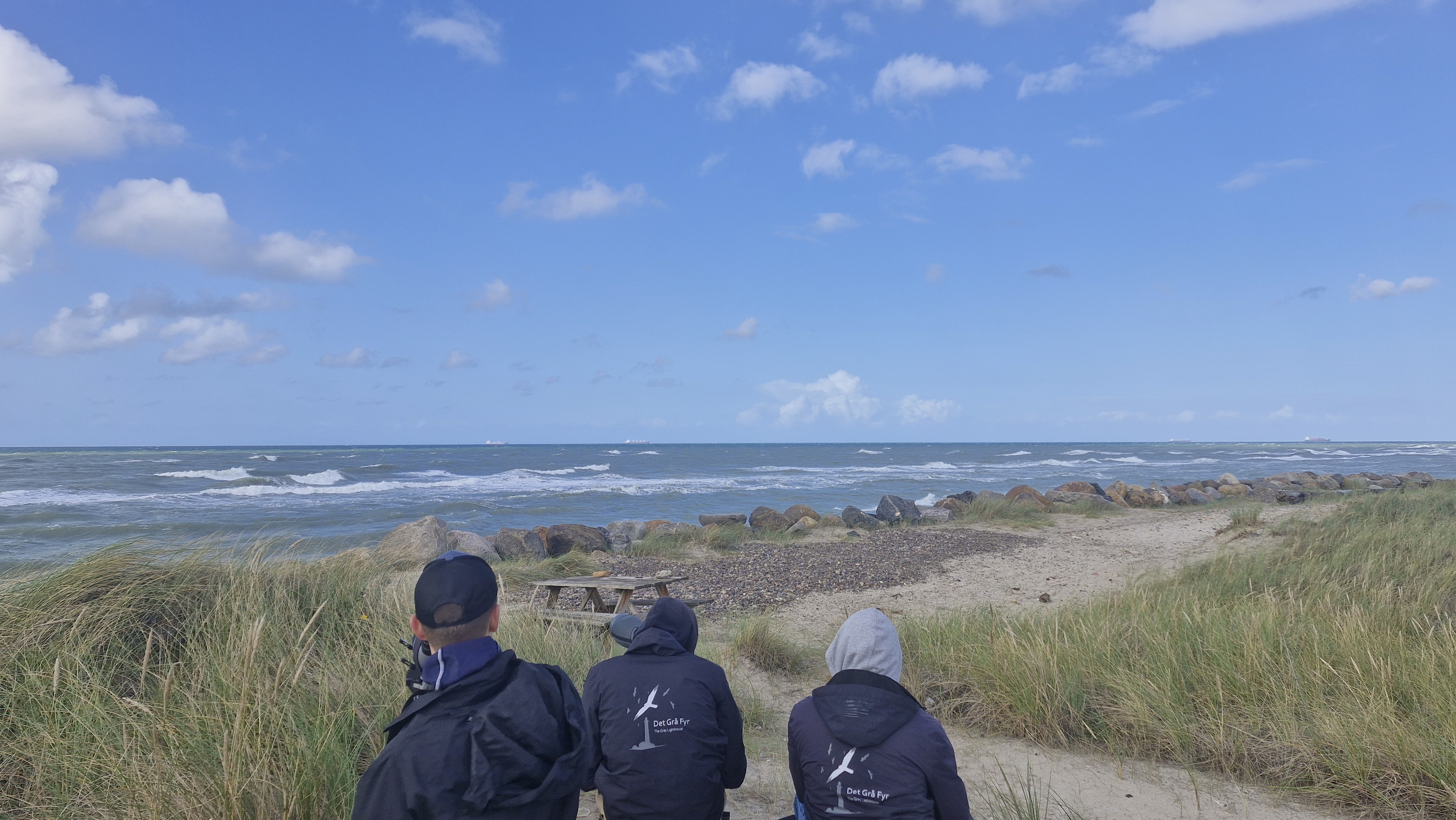
The SKAF crew out at Højen Fyrvej, sea watching in the afternoon sun.
We’re now sat doing some admin and mulling over tomorrow’s weather forecast while Ragnar is cheffing up a “meringue Nutella cake with a biscuit bottom” – tune in tomorrow to see how it turns out!
Ringing (Kabeltromlen)
Løvsanger: 2
Gærdesanger: 1
Kærsanger: 1
Munk: 1
Tornsanger: 1
Havesanger: 1
Total: 7
Link to todays observations from observers in the area
People at the station: Ragnar Smith, Rosa Hicks, Fredrik Johansen, Ezra Sherwell, Simon Sigard Christiansen, Hans Christophersen.
Greenish Warbler, Green birds on Dofbasen and bittersweet tern
24th august was another exciting Skagen-autumn day!
The day started with the ringers going out opening the nets and me and Frederik going out to World End 3 to do the counting. The weather changed as the wind blows, but we ended up with some really good birds! Highlights from the counting were such as Manx Shearwater (Almindelig Skråpe), several Arctic Skuas (Almindelig Kjove), Great Skua (Storkjove) and the “usual” three Mediterranean Gulls (Sorthovedet Måge). With the Arctic Skuas there was a fun surprise hidden. We saw a 3cy. dark morph Arctic Skua that was colour-ringed and Knud went down to read the ring while Eric Christophersen got some really good photos of it. The ringing data was sent almost immediately to the relevant ringing authority and we got almost immediate answer. And what an answer we got! But a bit backstory first, 4th august 2022 an 1cy. Arctic Skua was found on the beach in front of Worlds End 3, the earliest recorded 1cy. Arctic Skua ever recorded in Skagen! And this one was also colour-ringed and we found out that it was ringed on the 23/6-2022 in southern Norway and 79 days later it was seen in Denmark, it was one of two ringed juveniles in the same clutch. Now 794 days later this one was seen at the same beach and apparently it was the sibling to the one we saw in 2022! What a crazy coincidence and is a great showcase of why colour ringing is such a great tool in monitoring and data collection within ornithology.
 Ringing data for the skua from today
Ringing data for the skua from today

Ringing data from the one seen 4th august
 The colour-ringed Arctic Skua 3cy. dark morph from today
The colour-ringed Arctic Skua 3cy. dark morph from today
But while we were having fun at Worlds End 3, Kabeltromlen were their fair share of fun. First they caught a nice 1st year male Bluethroat (Blåhals) and had a singing and calling Greenish Warbler (Lundsanger)! 41st record in Skagen and 13th autumn record, quite the rarity and everything was called out on Zello for everyone to hear. But for some reason none of us at Worlds End 3 got the Zello messages, so imagine my surprise when Simon calls me and nonchalantly tells that the Greenish Warbler is stilling hanging out at Kabeltromlen. So I picked up my bike and went down to see it and hopefully photograph it, and while I was there they also told me they had a Bluethroat?! Thankfully I have seen both but imagine if it was something crazier and we missed it. I got the Greenish Warbler thankfully though the photos left a lot to desire. I went back to the obs and it didn’t take too long to find a Manx Shearwater, what a combo.
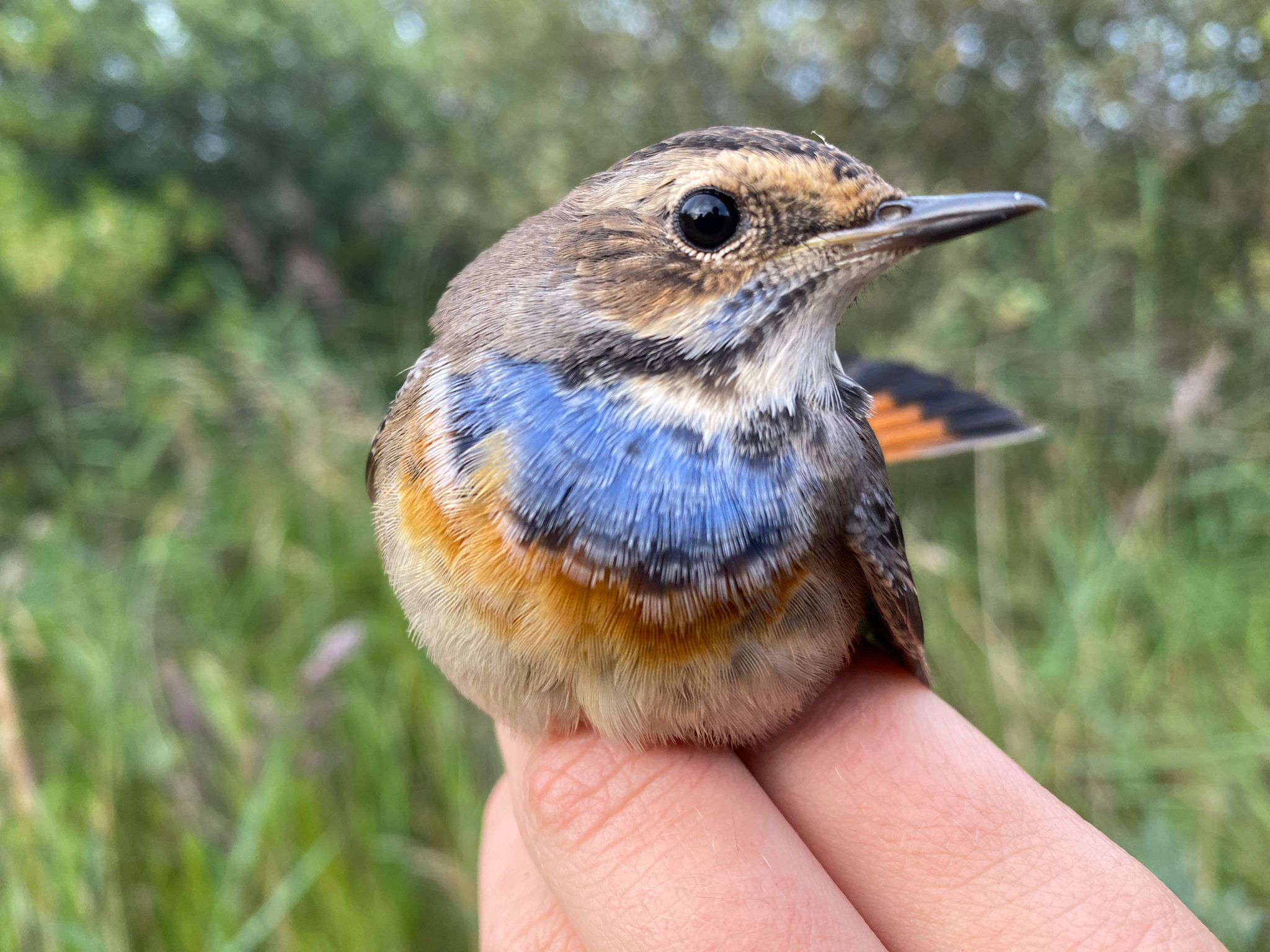 1st cy. male Bluethroat
1st cy. male Bluethroat
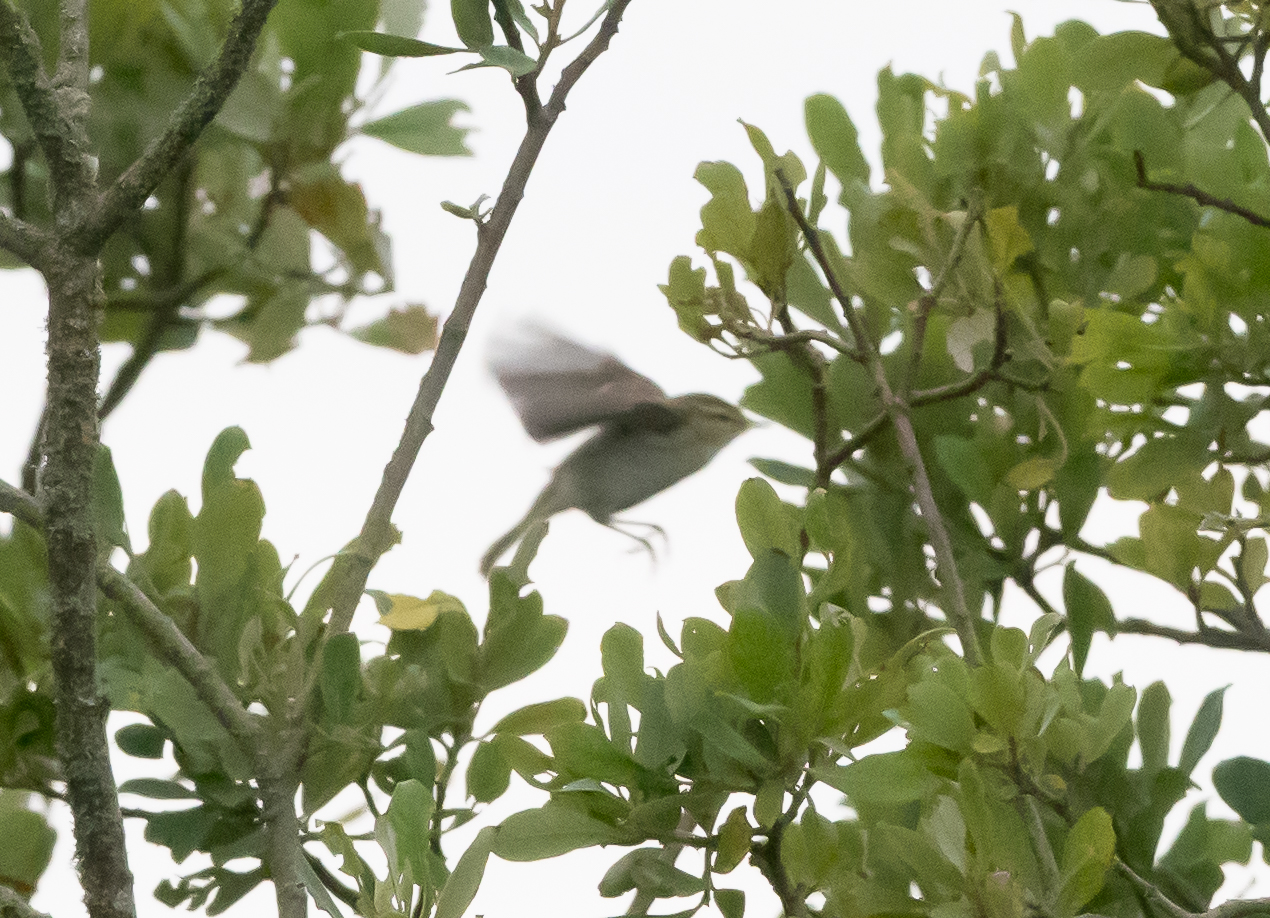 Greenish Warbler! notice the bigheaded impression, bright, strong supercilicum and dark loral stripe
Greenish Warbler! notice the bigheaded impression, bright, strong supercilicum and dark loral stripe
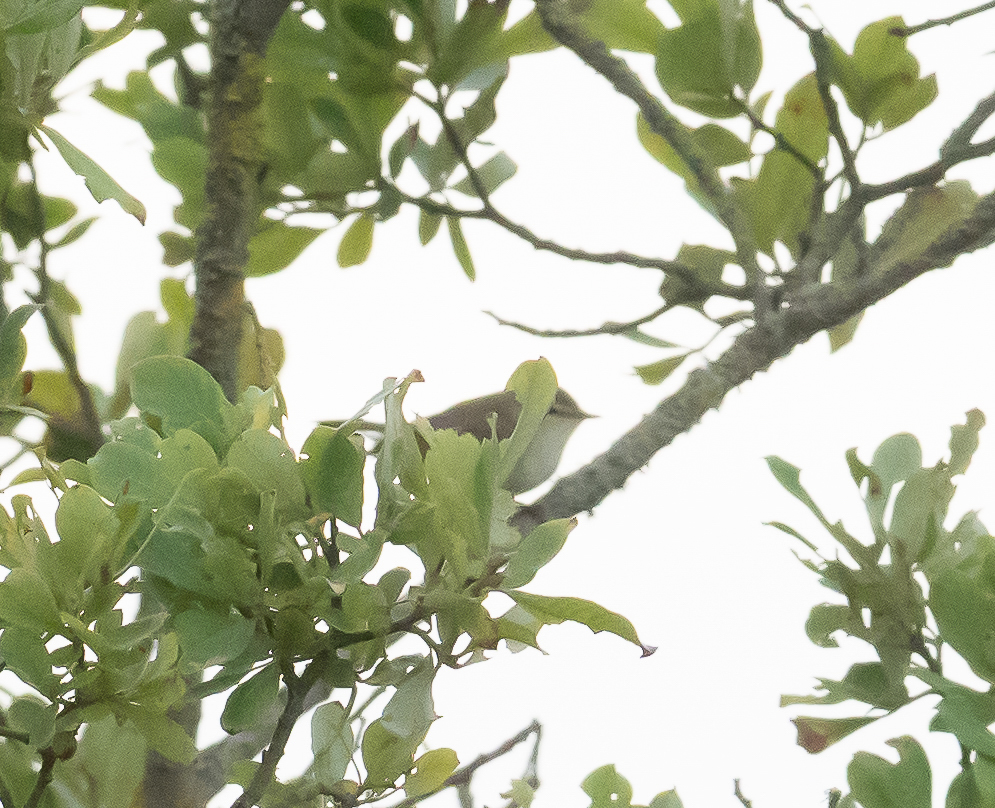 If it wasnt for the leaf, the wingbar would probably be visible, but here the mossy green upperparts are also visible
If it wasnt for the leaf, the wingbar would probably be visible, but here the mossy green upperparts are also visible
Recording of the Greenish Warbler
After an exciting obs we went back to the observatory to regroup and then we went to Højen Fyr trying to do some seabird watching, while on our way Frederik told me he needed a Sooty Shearwater (Sodfarvet Skråpe) for his self-found list. And almost immediately when we arrived he found one! We saw it very well and not long after he found another one! We left from there quite happy and immediately went to Worlds End 1 as the wind turned southeast, which means that seabirds are being pushed out from the Kattegat. There we managed to see a very nice Sooty Shearwater that came quite close and two Great Skuas.
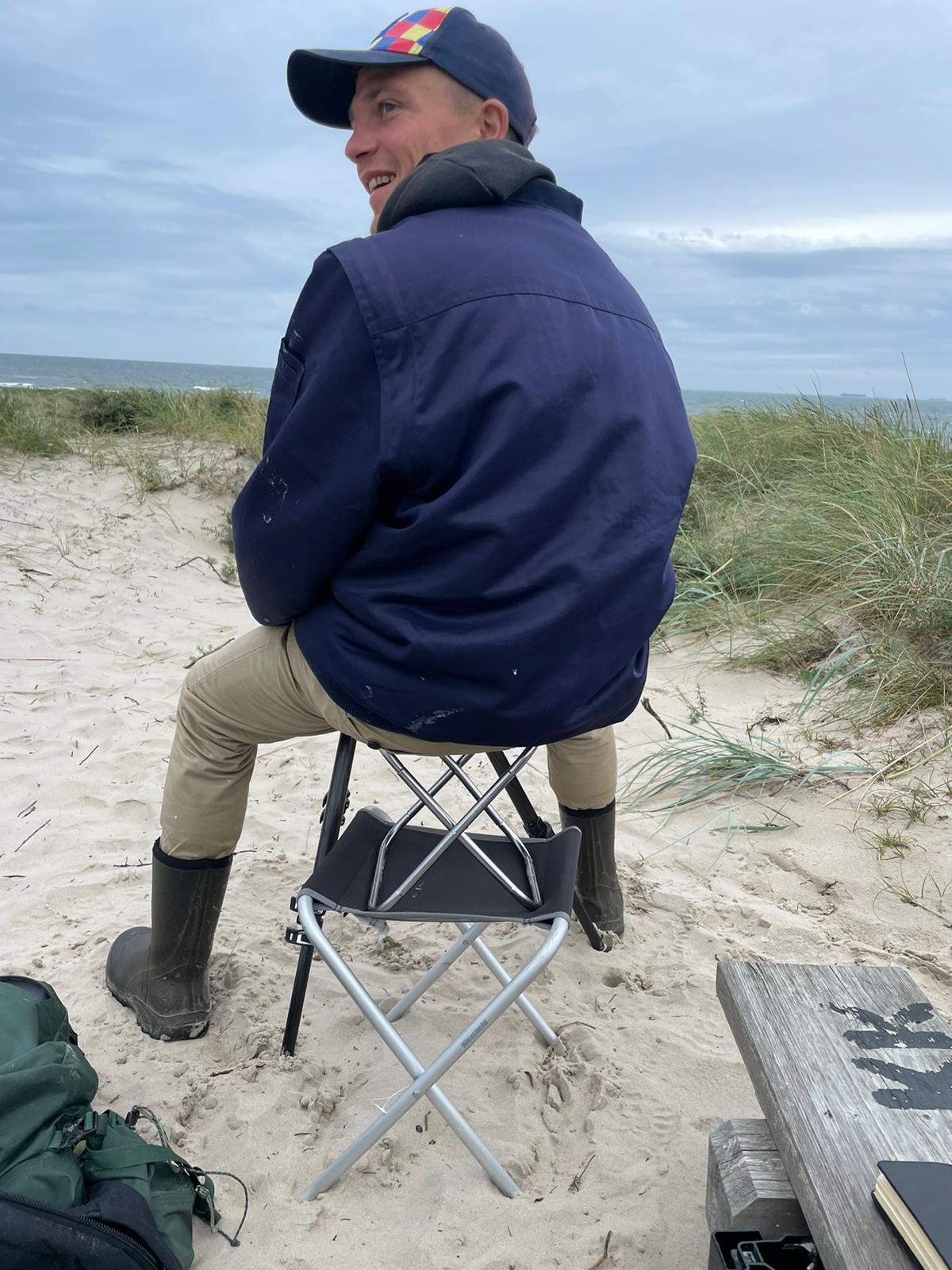 You sit a bit low at Worlds End 1, so to peep over the tall grass you have to be creative
You sit a bit low at Worlds End 1, so to peep over the tall grass you have to be creative
We were quite happy, but we were still hoping to find something like a Cory’s Shearwater (Atlantisk Skråpe) or something crazier, and we did almost. Like having a wish granted by a Monkey’s Paw, I found a strange tern while we were packing our bags around 1740, it was flying with a Common Tern (Fjordterne) and immediately I was struck by it flew with lackadaisical wingbeats going straight up and down, compared to common terns more focused and energetic wingbeats, shorter tail, heavier build and a short bill, I was completely blank and yelled out “check this tern” and he got on it and then we followed it fly away. Here we saw a grey back, grey wings with paler coverts, no obvious dark in the primaries, broader, more roundish primaries and when it reached the outermost dunes it turned around where it showed grey outertail feather and no obvious streamers and again a short, thick bill, like a heavy arctic tern bill. It looked like it went down, and we just stared at each other. What was that??? We discussed it and concluded that it could be a Whiskered Tern (Hvidskægget Terne) and after discussing what we each had seen, we walked towards the beach trying to refind it, while also putting it out on Zello as a possible Whiskered Tern with several birders also heading out to the beach looking for it. We spent 1 ½ hours looking for it, but no dice. It would have been the second or third autumn record ever for Denmark and the first record for Skagen since 1983! A great day with a bittersweet finish, but this is what we live for as birders.
Video of migrating Sooty Shearwater (Sodfarvet Skråpe) from today
Ringing (Kabeltromlen):
Rødhals (European Robin) - 1
Bynkefugl (Whinchat) - 1
Blåhals (Bluethroat) - 1
Kærsanger (Marsh Warbler) - 2
Rørsanger (Reed Warbler) - 3
Gærdesanger(Lesser Whitethroat) - 2
Tornsanger (Greater Whitethroat) - 3
Munk (Blackcap) - 3
Gransanger (Chiffchaff) - 2
Løvsanger (Willow Warbler) - 7
Total: 25
Link to today's observations from observers in the area
People at the station: Ragnar Smith, Rosa Hicks, Fredrik Johansen, Simon Sigard Christiansen, Torben Præst, Susanne Præst, Mette Møller Christensen.
I'm back!
Efter tre års fravær fra Skagen Fuglestation er jeg nu tilbage og så skal der jo selvfuglevis blive arbejdet hårdt igennem, for at finde nogle lækre fuglearter til nabolaget;)
Så sæt jer til rette, find en læskende drik og nyd en gammel kendings blog;)
Men inden vi går helt i gang skal I da ikke snydes for en vild nyhed!!
Ja, faktisk en ”førstegangs” i Skagen Fuglestations historie. Der er nemlig blevet genfanget en Kærsanger, som blev ringmærket her på fuglestationen!
Fuglen blev ringmærket den 29. maj og blev så genfanget den 20. august i Bács-Kiskun i Ungarn.
Inden vi går helt i gang med dagens strabasser, så får I også lige et hurtigt recap på hvad der skete af heftige sager nede i Himmerland i nat.
I nat var Simon, Andrew og Rosa nede omkring Ålborg for at prøve lykken med noget tredækker-fangst. Det lykkedes dem at se tre på to lokaliteter hvoraf de var så heldige at fange den ene af dem på nogle marker i Himmerland. Eftersom at vejrudsigten for dagen efter (i dag velogmærke (23. august)), så de forsøgte fangst længere ud på natten for så at få en overnatning hos Simons mor, som lavede dem lækker morgenmad:)
Nå, lad os så komme i gang med fuglefolkenes oplevelser for i dag:)
Ragnar og jeg havde valgt at blive hjemme for at forsøge noget obs og lusk. Vejrguderne var dog ikke med os og efter at vi havde vågnet hver halve time siden klokken fem, for bare at kunne se en vejrudsigt der sagde "røv og nøgler", da kom endelig et fald i vinden og et svagere regntryk. Vi kørte så ud mod Grenen og satte os i klitterne vest for Sandormesvinget. På vejen kunne jeg glæder mig over en ny Danmarksart; nemlig den stationære Cistussanger, som blev fundet af Rolf Christensen omkring den 14. august. Det blev min art nummer 383 i Danmark.
Obsen gav ikke det helt store, men efter endt obs tog vi ud for at tælle småfuglefaldet. Havde kørt med skopet og scannet krattene i reservatet og Grenen for at blive mødt af krat levende med småfugle!
Af nævneværdige fugle fra obsen og lusketuren kan nævnes:
Cistussanger,
Sorthovedet måge 3 ungfugle
Kaspisk måge 2 ungfugle
Broget fluesnapper 2
Og så en lille joker(?)
Under lusken hørte Ragnar og jeg lige pludselig nogle sylvia-kald, som skilte sig markant ud ift. de omkringværende gærdesangere. Ja, den skilte sig så meget ud at vi begge to stod måbende, fordi at vi begge to havde en mavefornemmelse der sagde ”HIT!”.
Mens den kaldte løs på livet løs, gik vi hurtigt ind for at tjekke kaldende på vestlig og østlig hvidskægget sanger, og ja, der var et match! Faktisk matchede vestlig hvidskægget sanger rigtig godt! Vi blev ved med at høre den, men ikke se den, og grundet vind og vejr og rent adfærdsmæssigt for nogle af fuglene, og sjovt nok også inden for den art (idet at de godt kan lide at trykke sig/fouragere dybt nede i et krat), så så vi den aldrig. Så både Ragnar og jeg tigger og ber’ til at den bliver taget i ringmærkningen i morgen!
Der blev gjort et forsøg på at genfinde den med assistance fra Rosa, dog uden nogen fortjeneste at kunne dele med resten af birder Danmark.
I morgen tager Ragnar og jeg ud på morgenobs og Rosa, Simon og Mette tager mærkningen ved Kabeltromlen. Det bliver en god dag…
Folk ved stationen:
Ragnar Smith, Rosa Hicks, Simon Sigard Christiansen, Mette Møller Christensen og Frederik Johansen.
